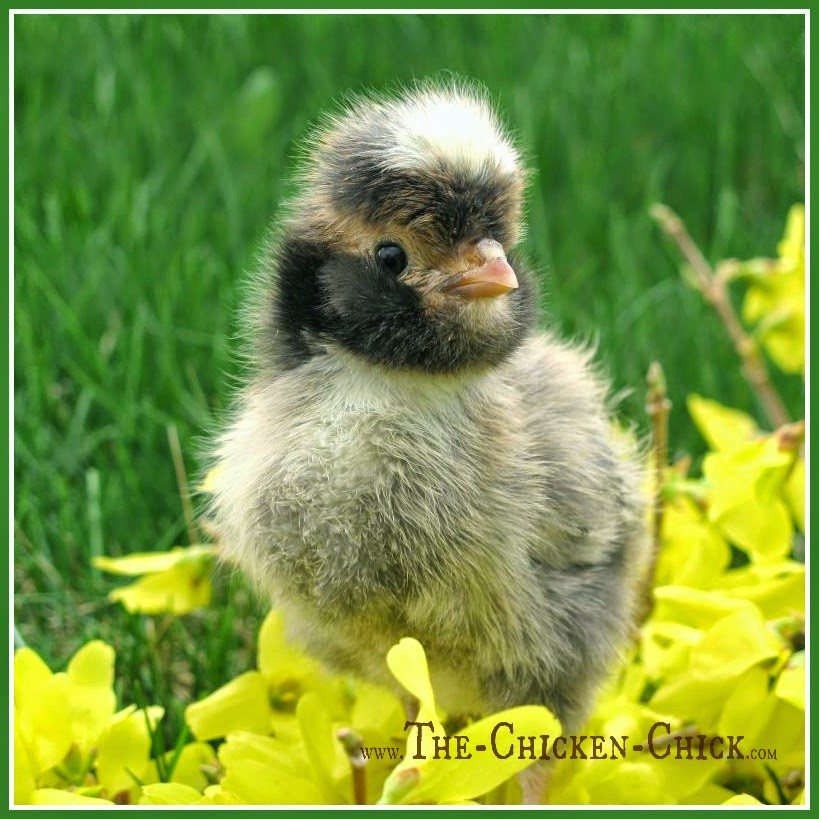
TIMING IS EVERYTHING
Build or buy the chicken coop before the chicks arrive! They grow at the speed of light and feather-weight baby chicks become poop and dust-generating machines in just a few weeks!
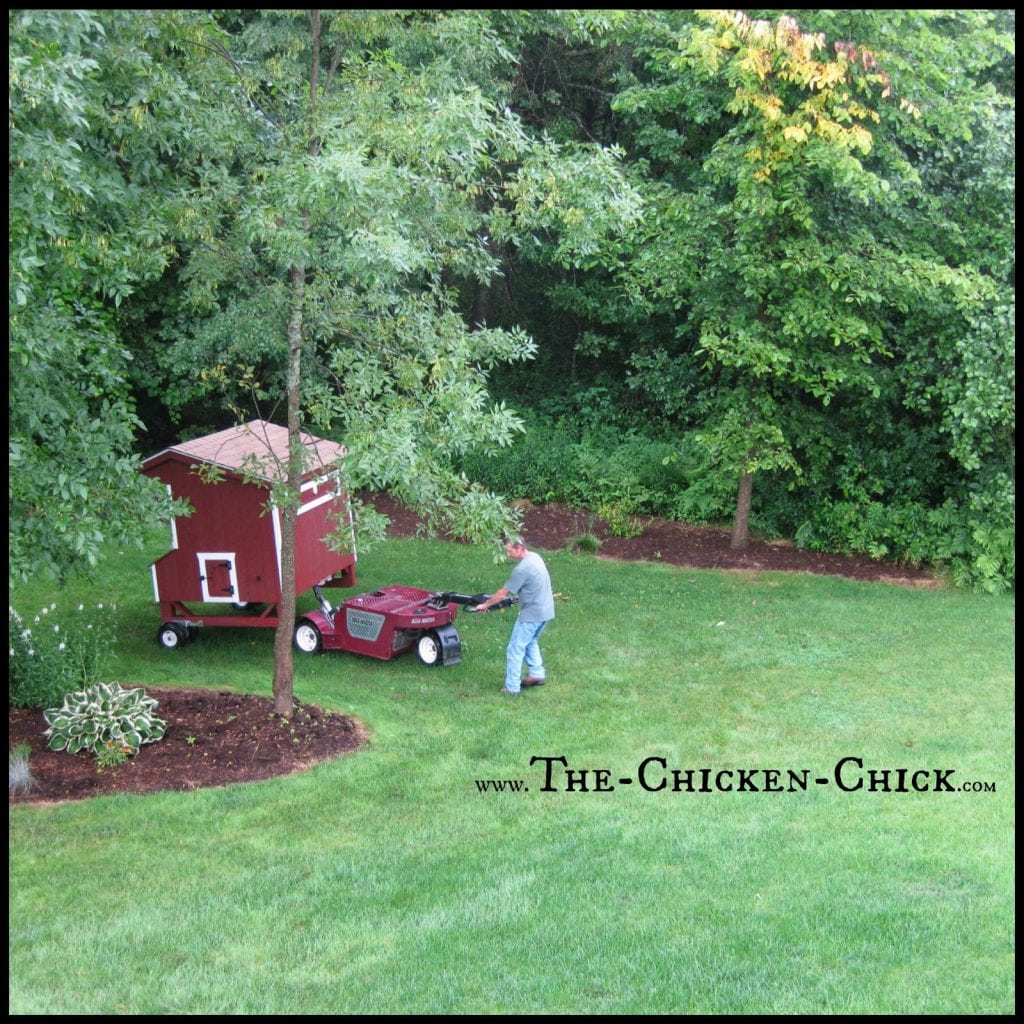
COOP LOCATION
Climate Considerations:
Anticipate weather-related challenges based on climate:
- Rainy climate? Locate chicken coop at the top of a sloped yard, not the bottom.
- Hot weather? Locate the coop in a shady spot.
- Frigid winters? Seek-out natural windbreaks.
- Super cold AND super hot seasons? Favor a shady location since it’s more difficult for chickens to keep cool in the heat than to stay warm in the cold.
- Wet climate? Avoid low-lying areas that can flood.
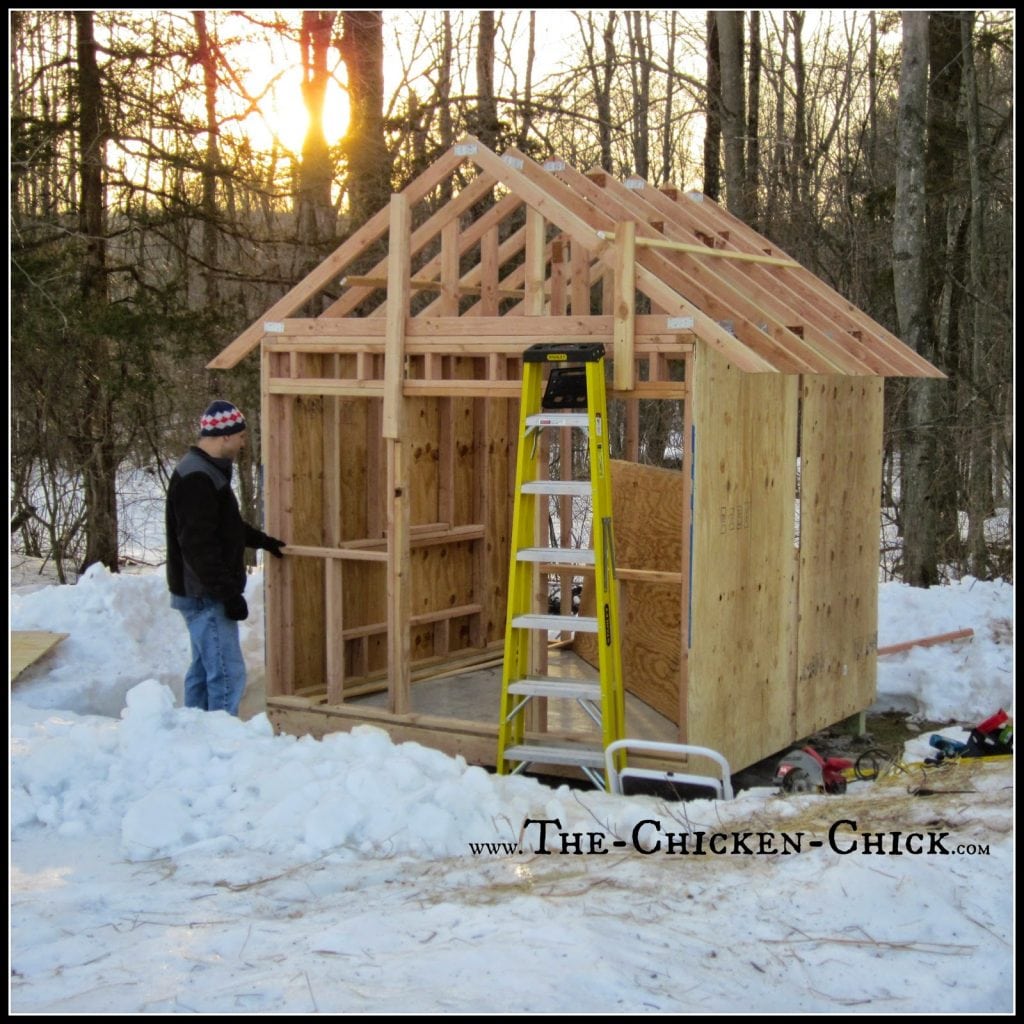
COOP SIZE: MINIMUM SPACE REQUIREMENTS
Allow at least 4 square feet per bird inside the coop. Plan a bigger coop than you think you need. Hear me now, believe me later: the coop should be twice the size of the anticipated need. Planning 6 chickens now? Build the coop for at least 12. There will be personnel additions to the flock!

FREE-RANGE VS. CONFINEMENT
Birds that live most of the day ranging outside the coop and run will only spend time inside the coop sleeping and egg-laying and will be fine with less than 4 square feet per bird.
Birds that are primarily confined to the coop and run should be given as much space as possible inside the coop, 4 sq feet is the bare minimum.
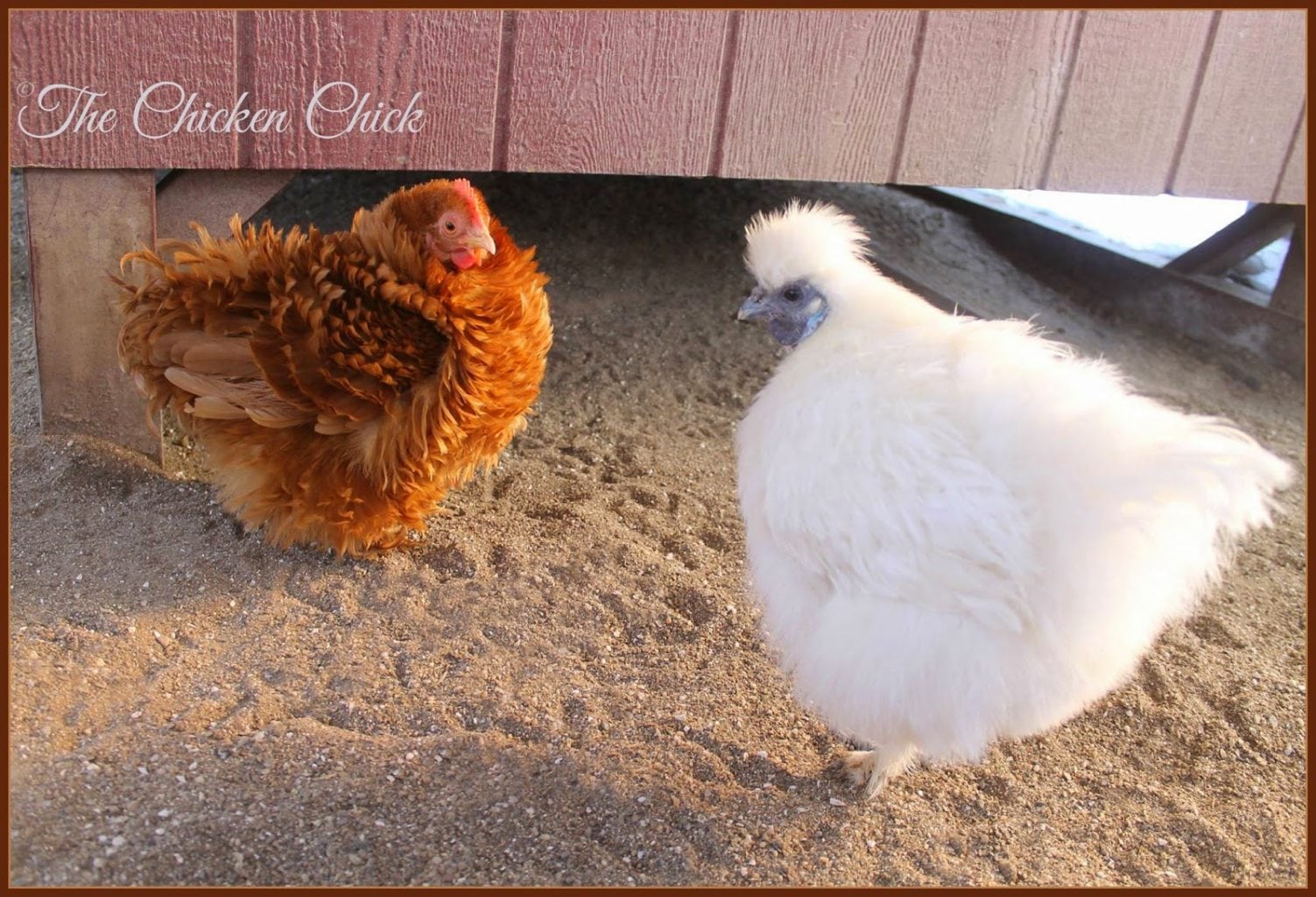
COOP ELEVATION
Raise the coop off the ground a foot or two- this creates additional outdoor square footage for confined chickens, a shady spot in hot weather, a dry space in the rain and a hiding spot for bullied birds. Elevating the coop also protects the bottom of the coop from wood rot. Secure the bottom of raised coops with hardware cloth, not chicken wire, to prevent predators from using the space as a hunting club or reaching a chicken inside the run.
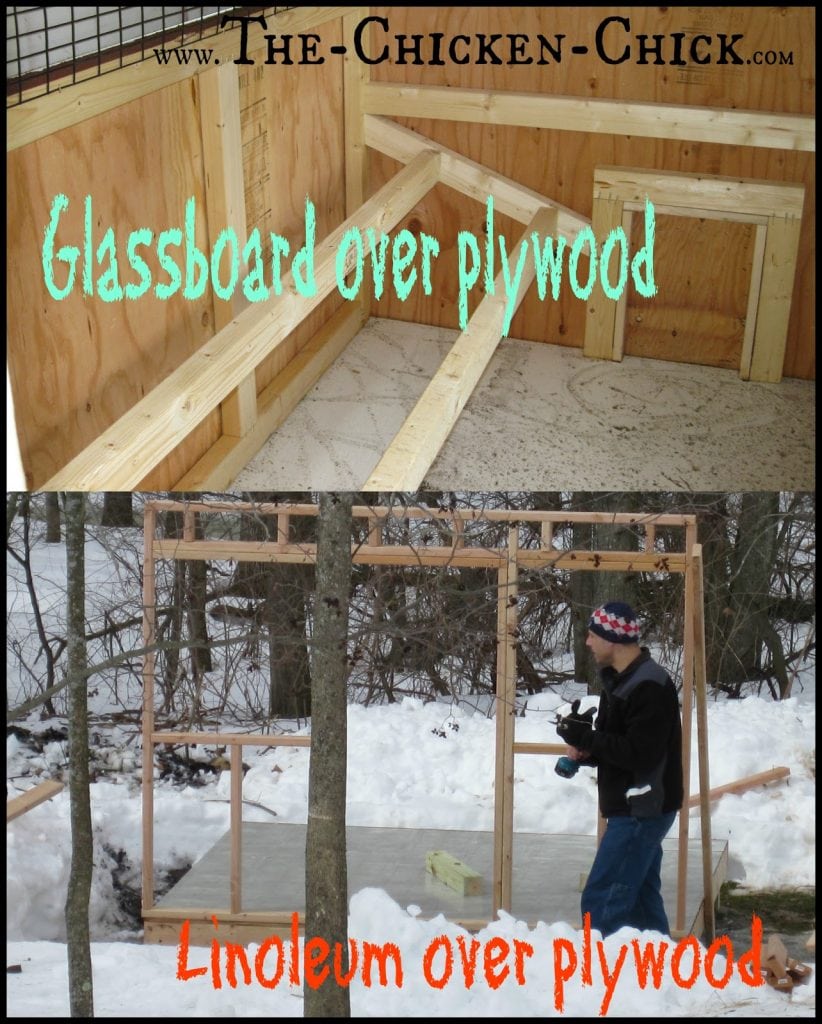
FLOOR
Protect wood floors from moisture and wood rot with inexpensive linoleum- it makes cleaning a breeze. Secure hardware cloth to the bottom of the wood floor (facing the ground) to secure against chewing predators. Consider a lip at coop door thresholds to to prevent litter from falling out.
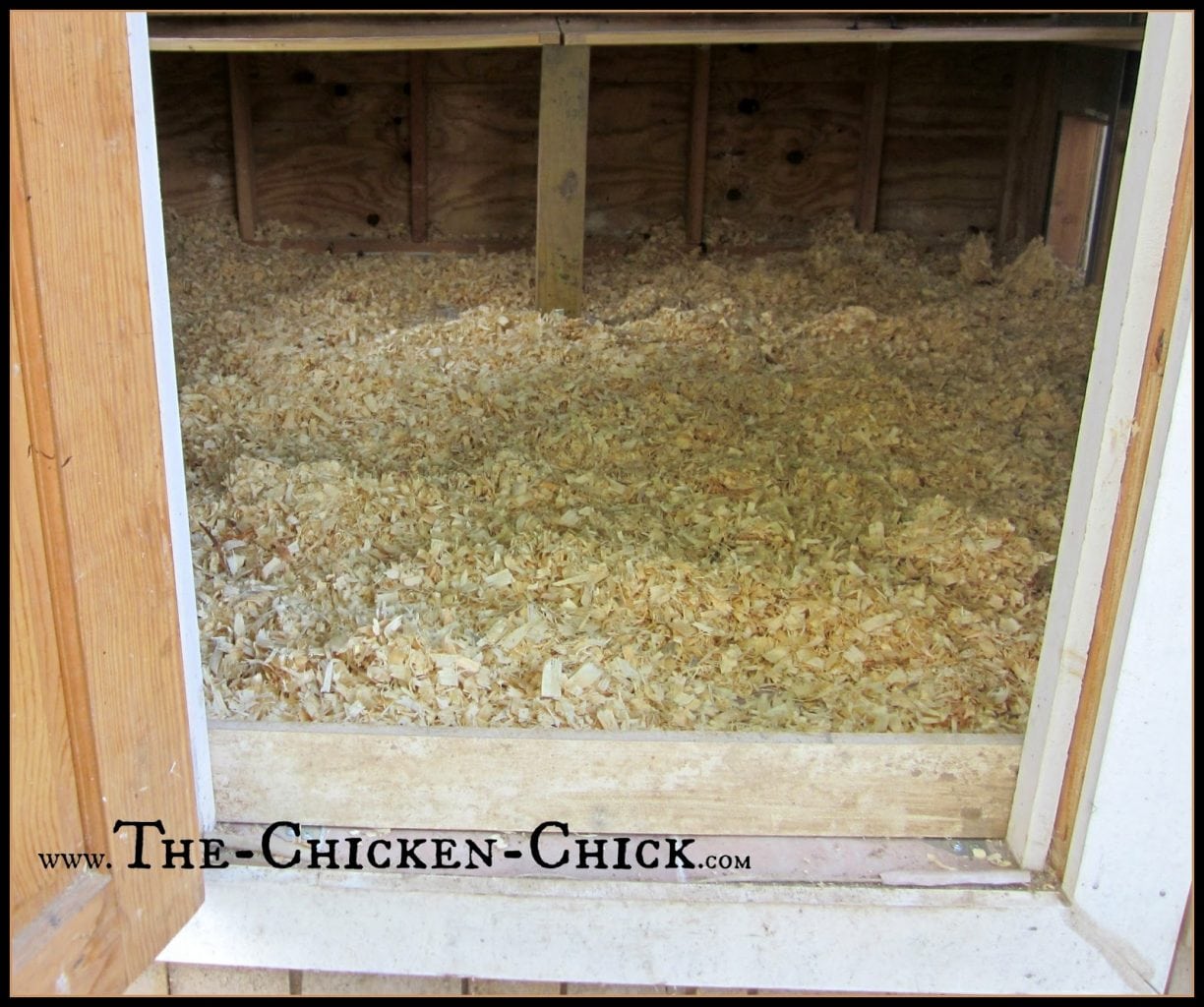
ACCESS
Think about how difficult it will be to get to the coop to care for the flock in the worst weather. How far is the coop from the closest water source? In hot climates, a mister may be necessary. In cold climates, shoveling, plowing, hauling water, feed and collecting eggs will be a major burden if the coop is too far from the house. Make the coop accessible. Every inch of the coop should be reachable not only for ease of cleaning, but for handling a sick or injured chicken.
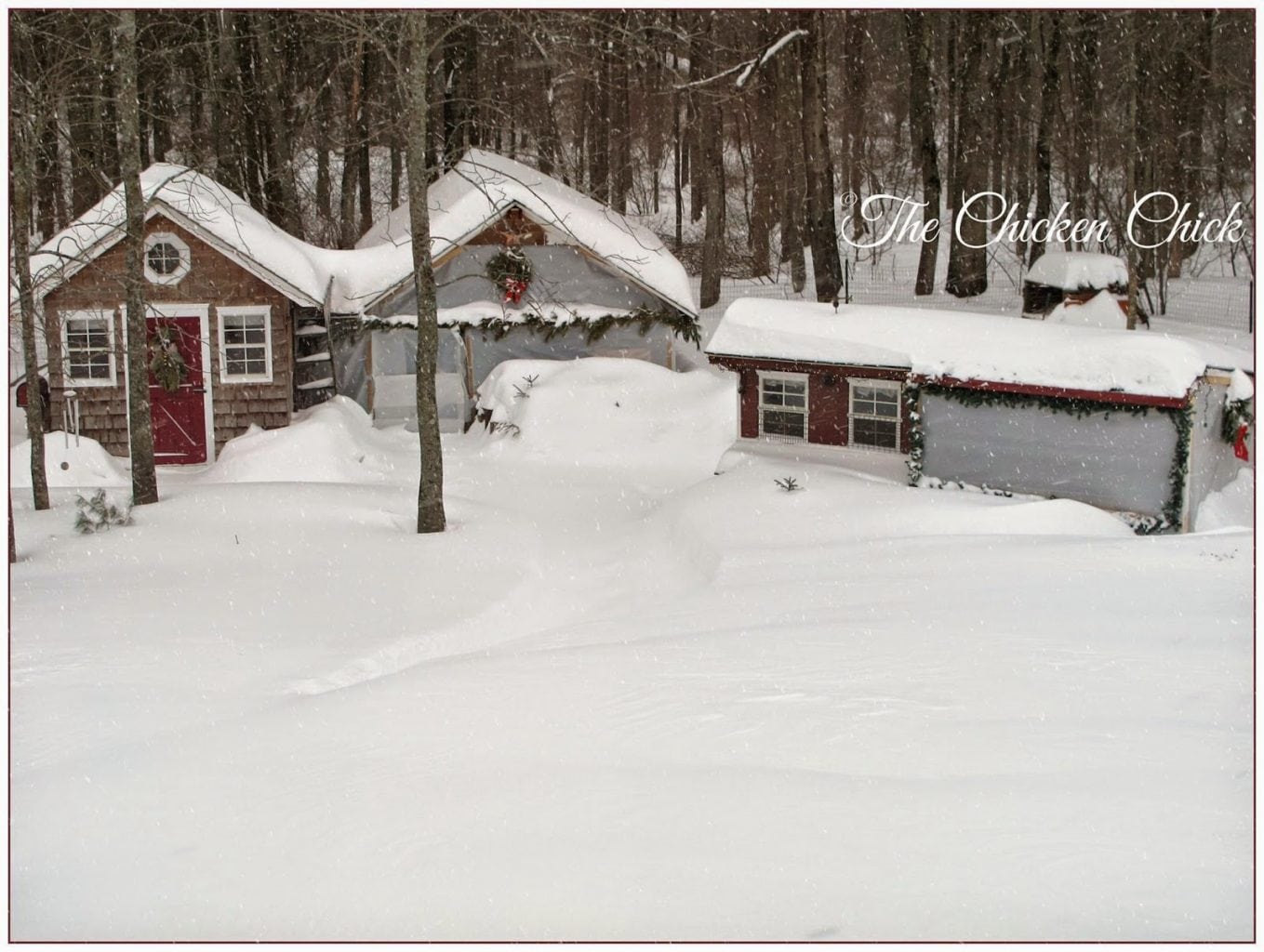
People door
Provide an access door that’s large enough to accommodate human caretakers, housekeepers and wait staff.
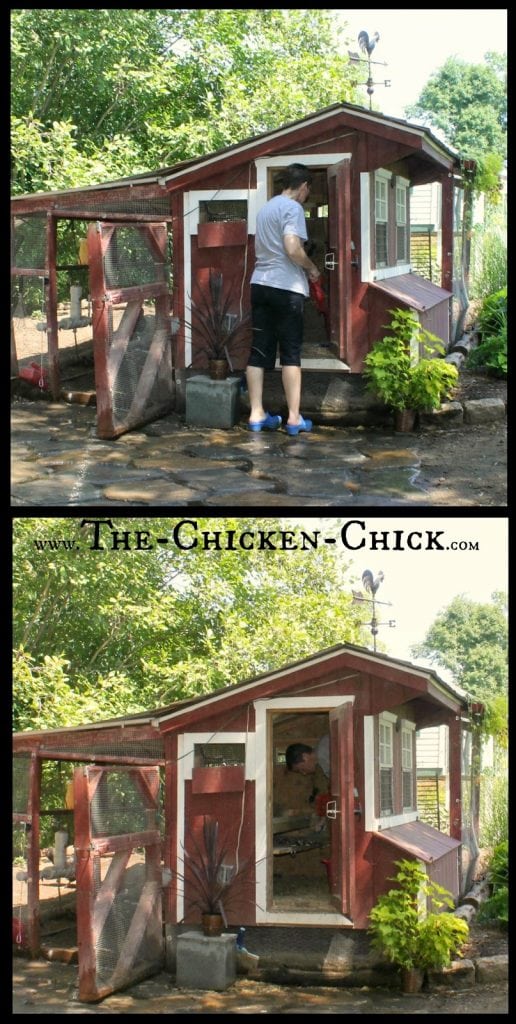
Chicken door
Chickens use a “pop door” to enter and exit the coop. 12” x 14” is fairly standard size. A small ramp ordinarily leads out of the coop ino the run.
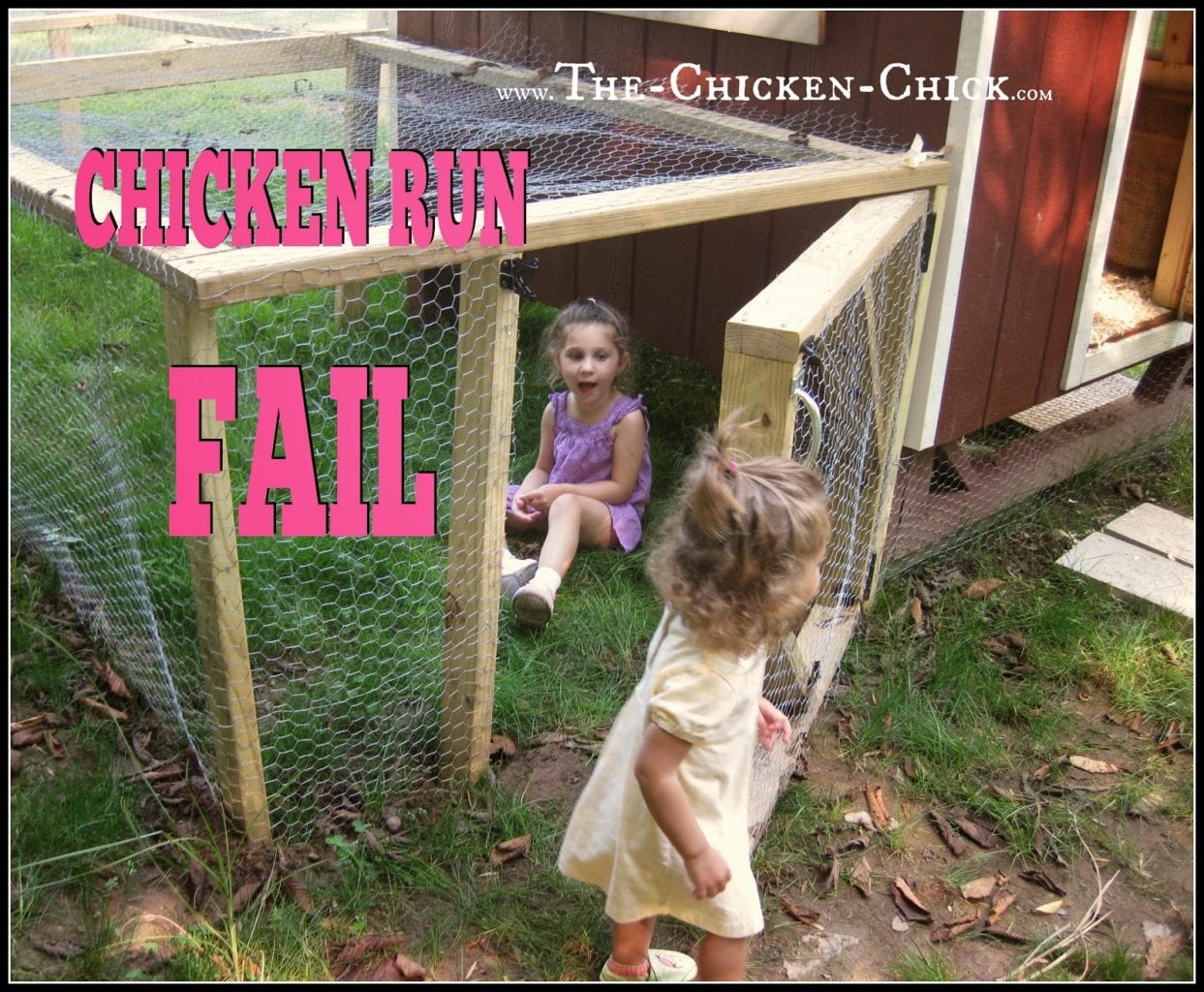
Access to Chicken Run
Make the door into the chicken run tall enough for people to enter without causing head injuries.

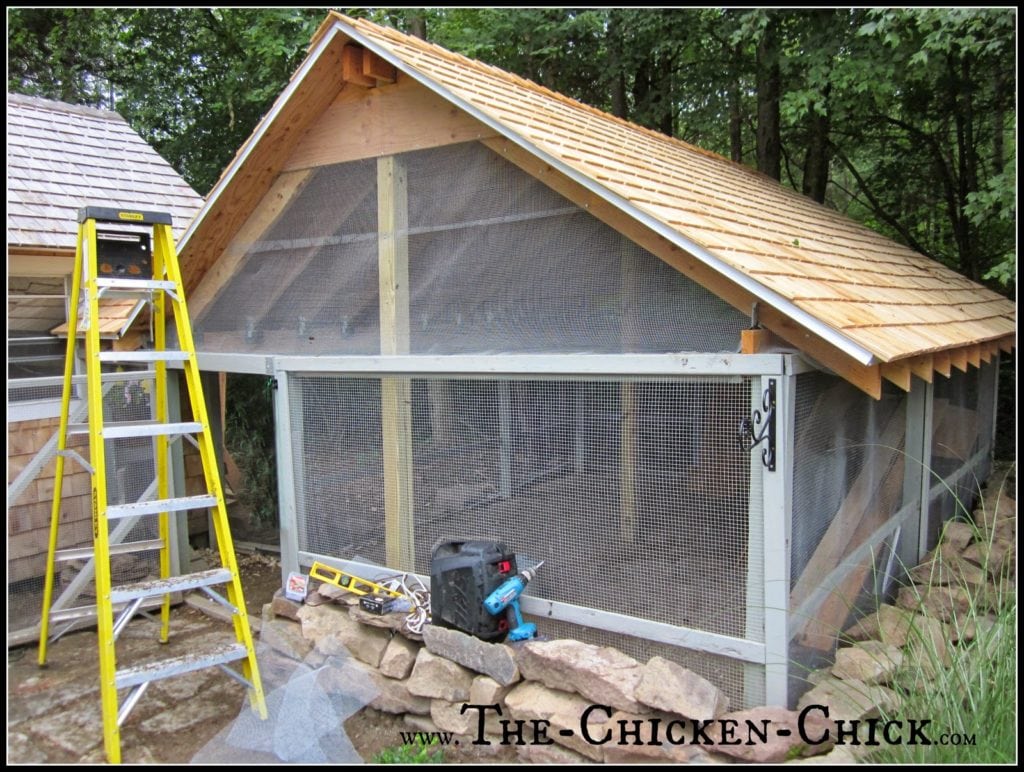
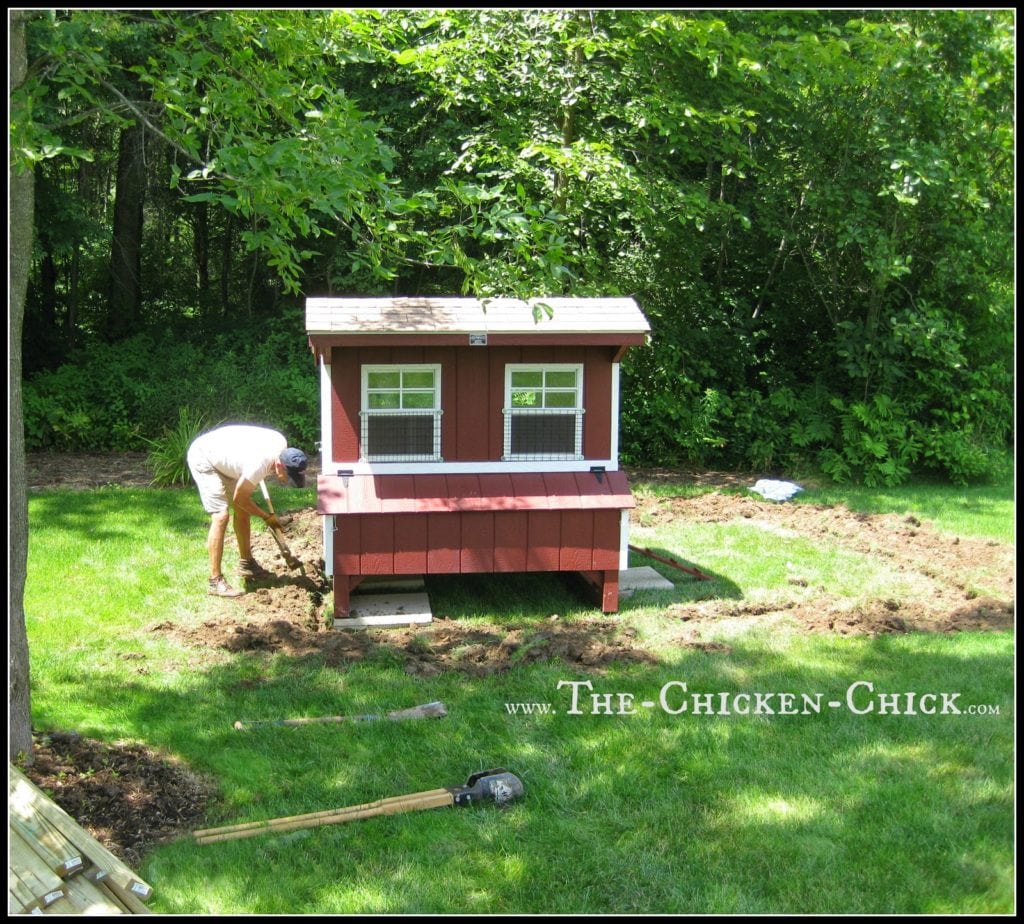
COOP SECURITY: Predator-proof the chicken coop
Install ¼ inch Hardware Cloth Liberally-Never Rely on Chicken Wire for Safety!
Secure every opening to the coop and run that is greater than ¼ inch with hardware cloth.
Deter digging predators by creating a 12″ trench around the coop perimeter and burying the hardware cloth. Alternatively, extend a hardware cloth apron 12” out from the perimeter of the run. An apron isn’t as effective as a trench, but will provide a degree of security from less ambitious digging critters. Much more about predator-proofing a chicken coop HERE.

Locks
Opt for barrel locks, padlocks, or any other lock that requires multiple steps to unlatch. Raccoons can operate simple locks and turn basic chicken coop door handles.
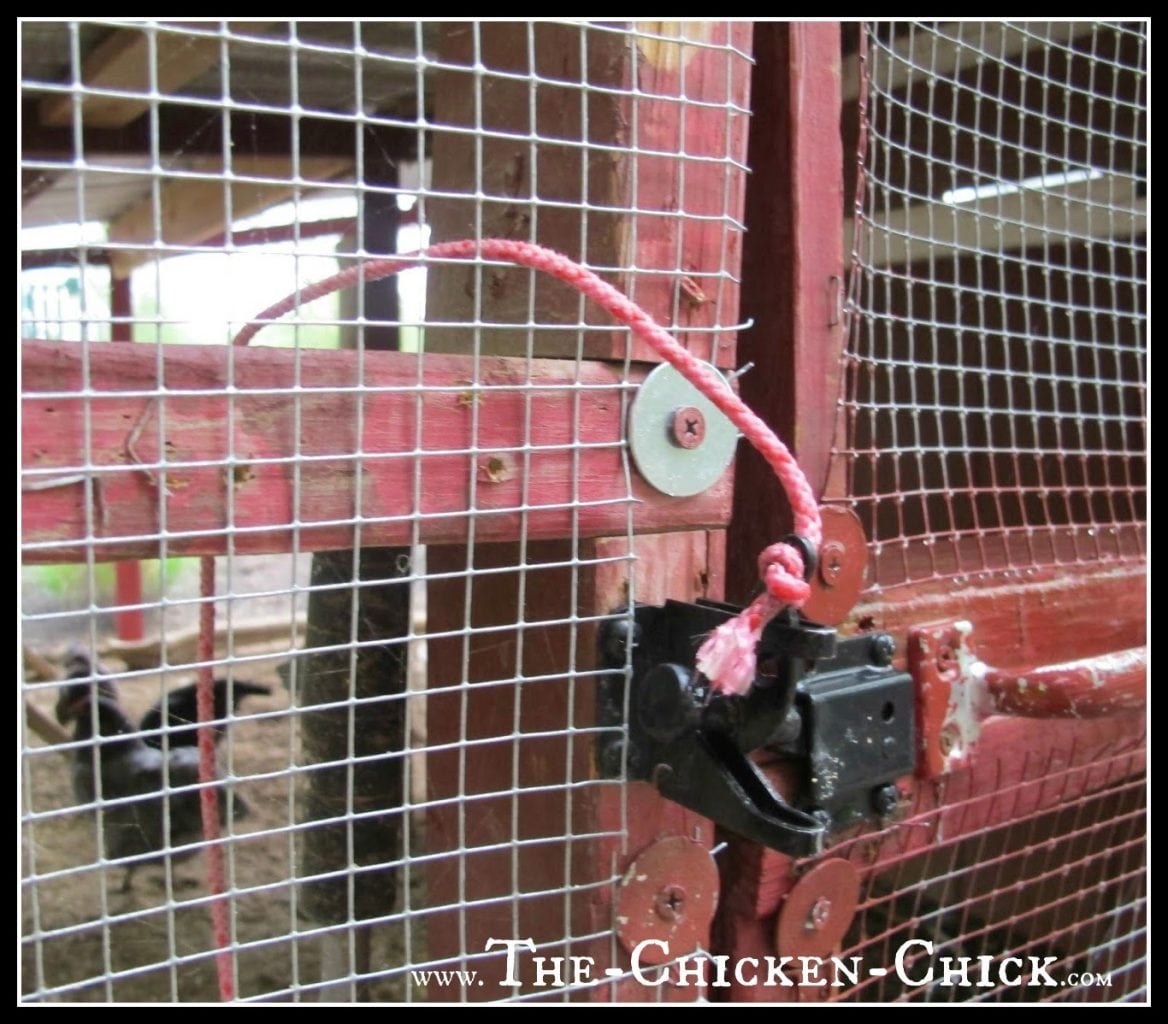
Plan an Escape
Formulate a human escape plan. Many chicken keepers have had the misfortune of locking themselves inside the coop or run- plan a way out.
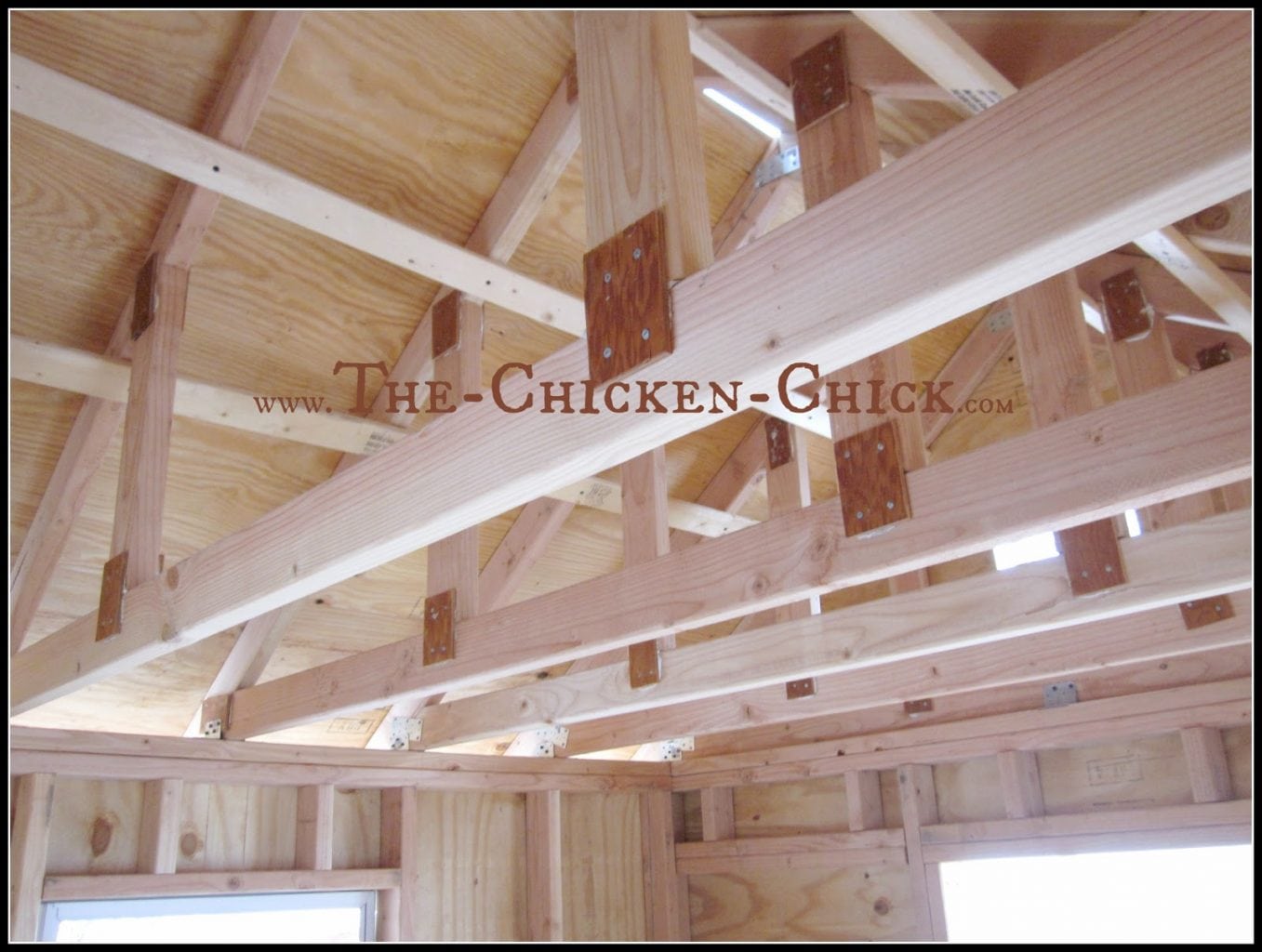
VENTILATION/CIRCULATION
Install as much ventilation as high up on the walls as possible. Air flow is vitally important in all seasons: harmful ammonia and moisture must be eliminated and fresh air brought inside to ensure flock health.
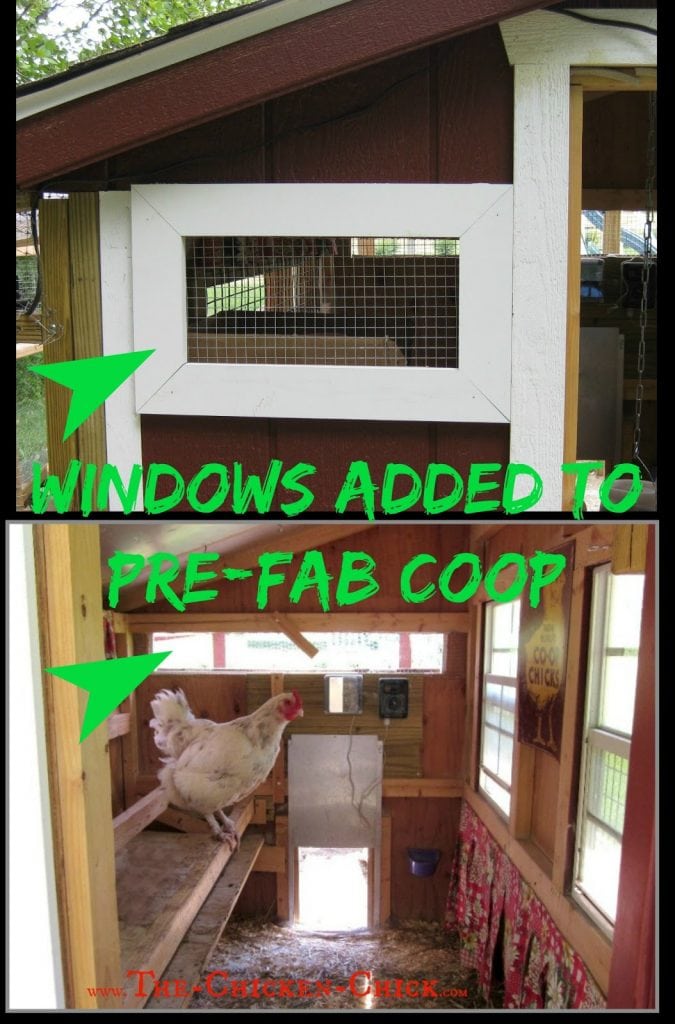
Place windows on all four sides of the coop with open gables and/or gable vents near the top of the coop to maximize air exchange, which is important in cold weather.
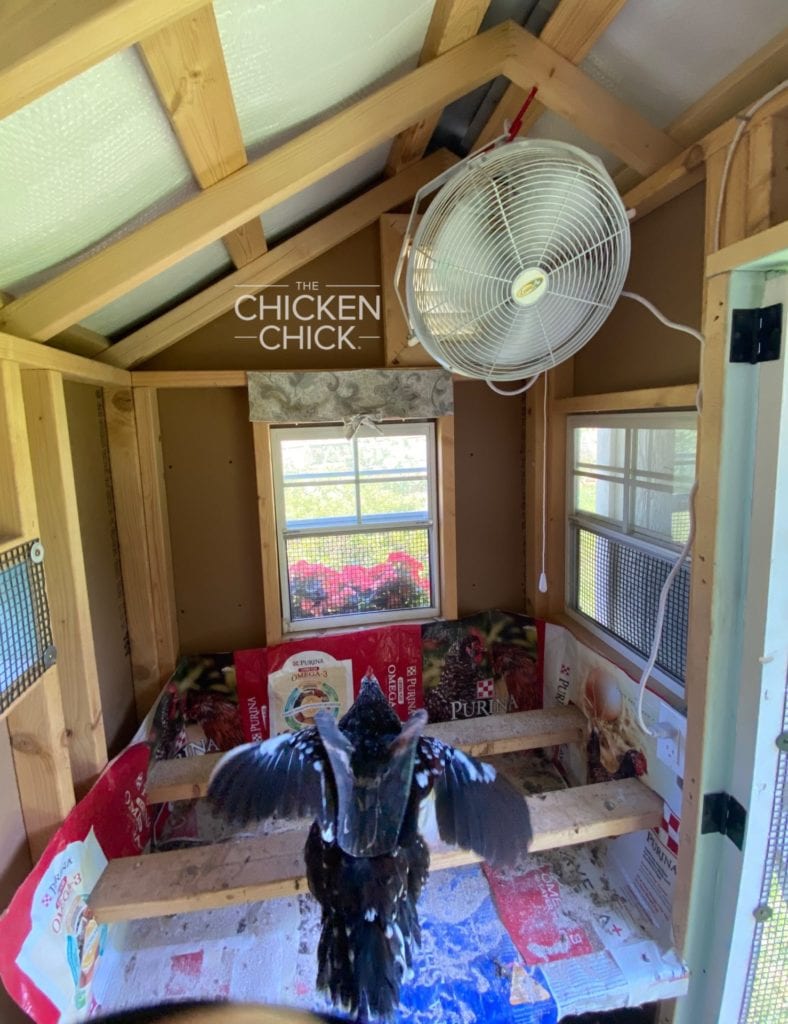
LIGHT/WINDOWS
Provide functioning windows for natural light and circulation. Chickens are not built for hot weather; they have a core body temperature of ~107°F, they wear down jackets, and have no sweat glands. Temperatures over 85°F are endanger their lives. Windows are not a coop luxury, they are a survival essential. Egg production is triggered by light– let it in! Secure windows with hardware cloth attached inside the coop with screws and washers to guard against predators.
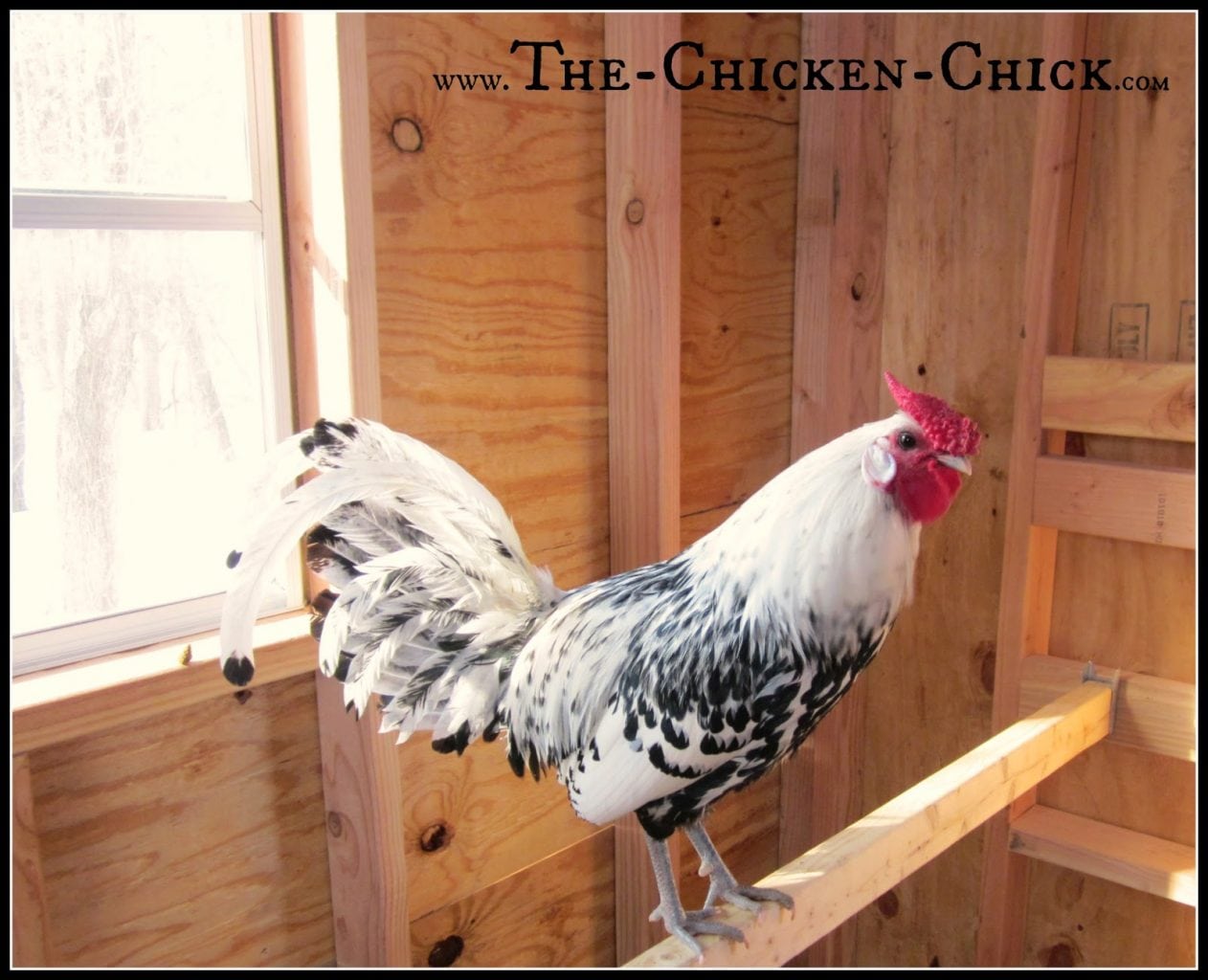
Plan for 8-12” of roost space per bird inside the chicken coop; 2x4s are commonly used as roosts, but natural tree branches accommodate the natural grip of a chicken’s foot better. Position roosts at least 12” from the nearest parallel wall, 12” from each other and no more than 2-3 feet from the floor unless a ladder is provided. I haven’t found that it matters which side of the 2×4 faces up- chickens can cover their feet to keep them warm in the winter either way.
Install roosts higher than nest boxes. Chickens instinctively prefer to roost as high off the ground as possible, if the nest boxes are higher than the roosts, chickens will sleep in the nest boxes and eggs will be laid in an unsanitary environment. Removable roosts are easily cleaned and periodically replaced.

DROPPINGS BOARDS: WASTE MANAGEMENT
Add droppings boards underneath roosts to collect chicken poop generated overnight, which removes the primary source of ammonia and moisture from the coop. Scrape boards down each morning and add them to a compost pile.
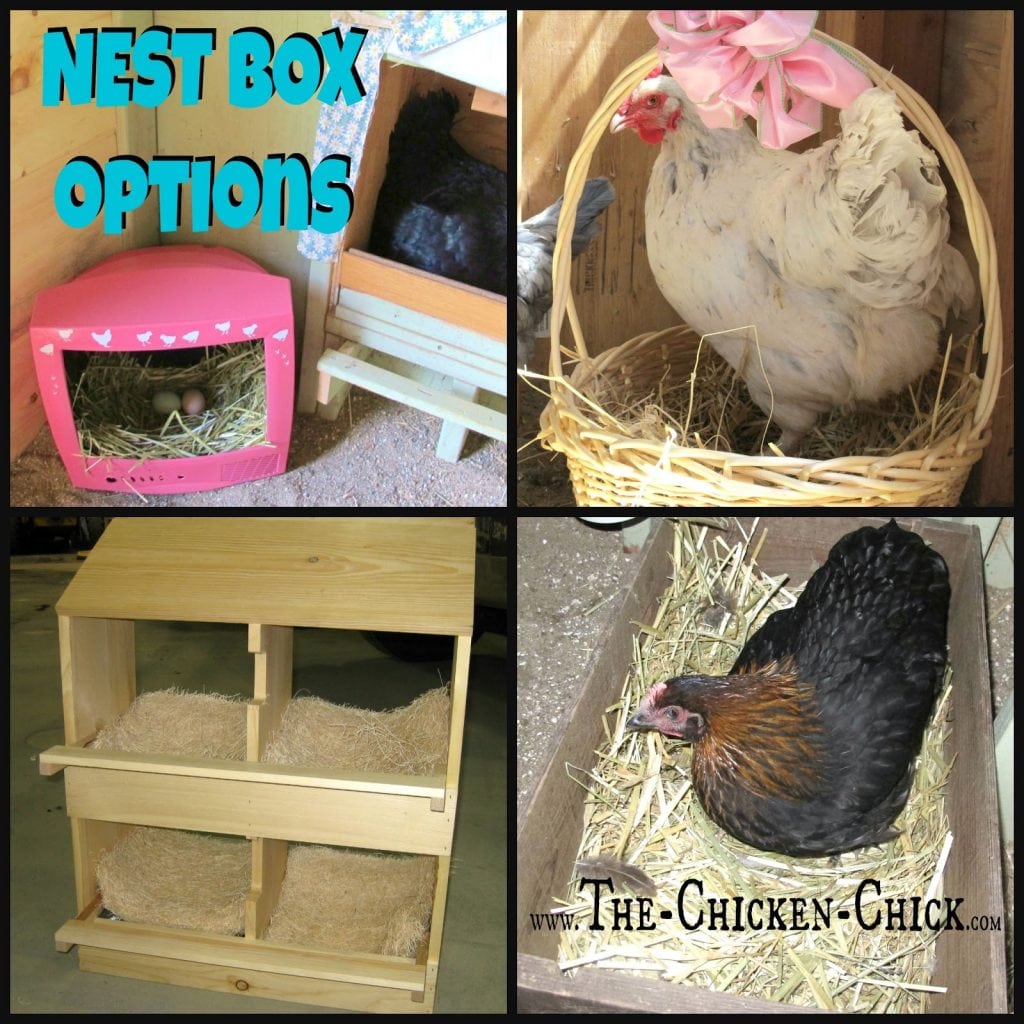
Provide one nest box for every four chickens. Nests can be at floor level or higher as long as they are lower than the roosts. Typical nest box size is 12”x12”12″. Don’t be discouraged when hens bicker over one nest box and several sit in it simultaneously- they all do it! It’s the equivalent of women going to the ladies room together. Safety in numbers, perhaps?
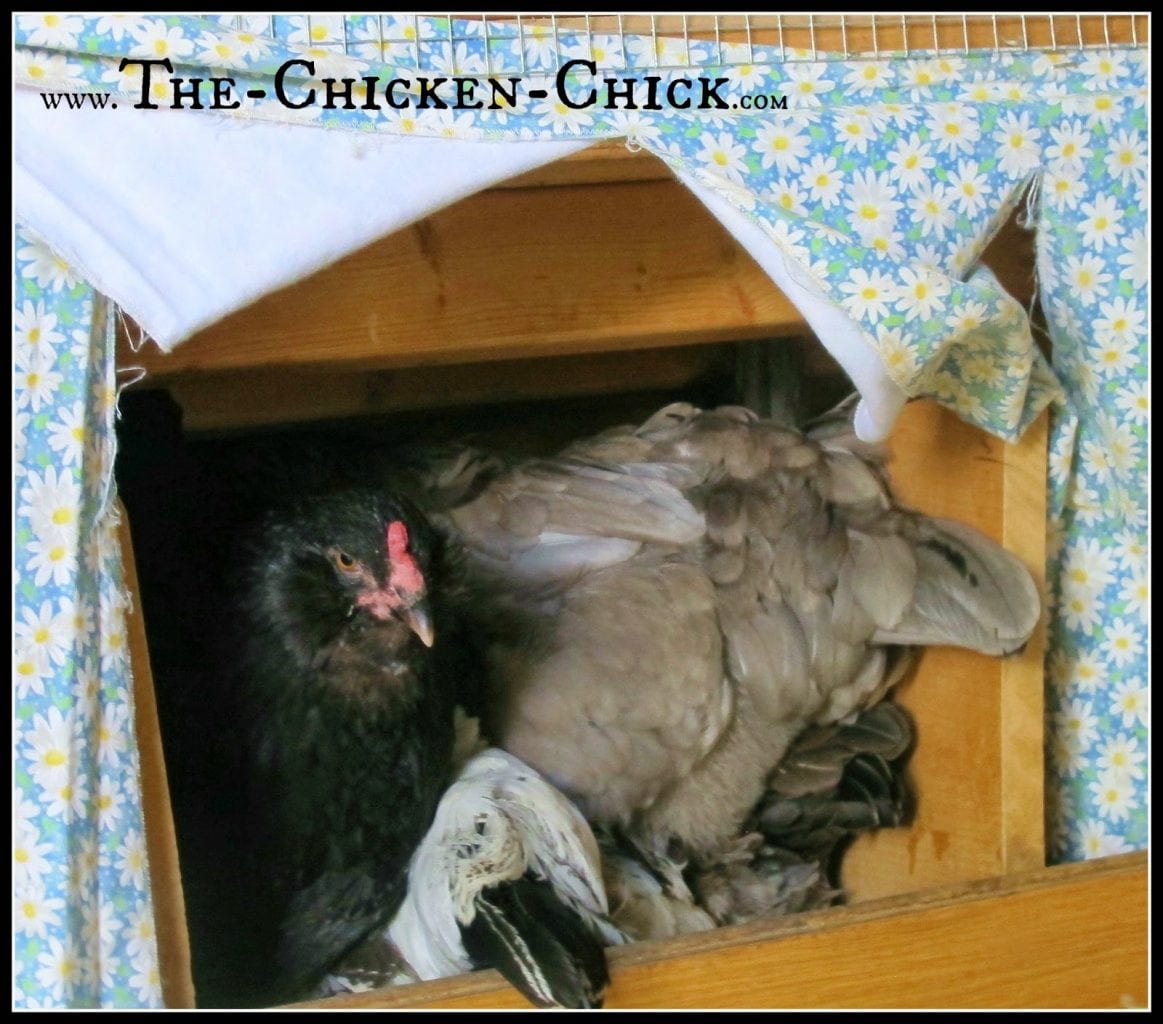
Be creative with nest boxes, the options are limitless: clean, empty kitty litter containers, 5 gallon buckets, baskets and upcycled televisions and computer monitors all work for laying hens!
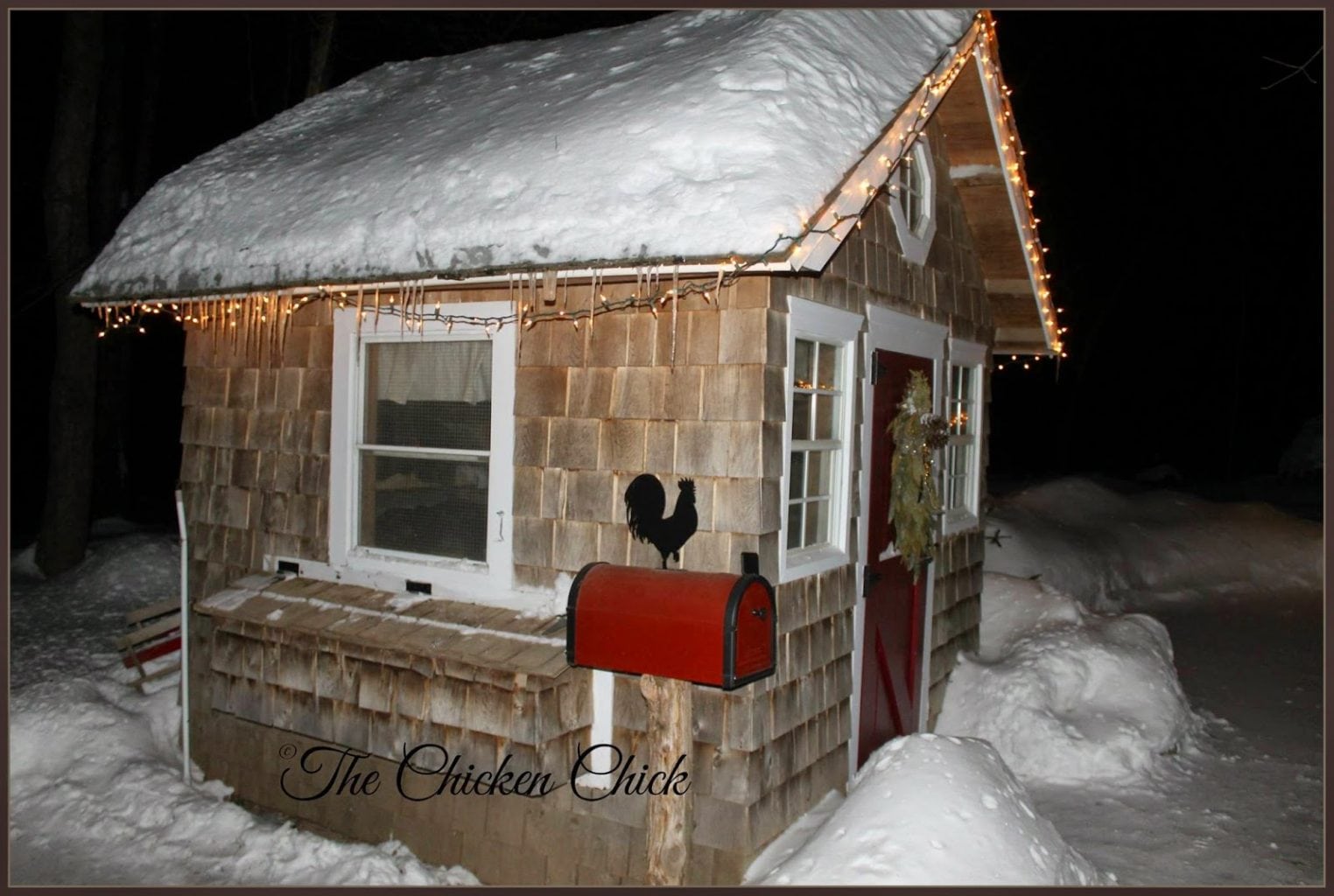
Egg access door outside the coop frees up valuable coop floor space and allows eggs to be collected in winter without letting any heat out of the coop or tracking snow into it.
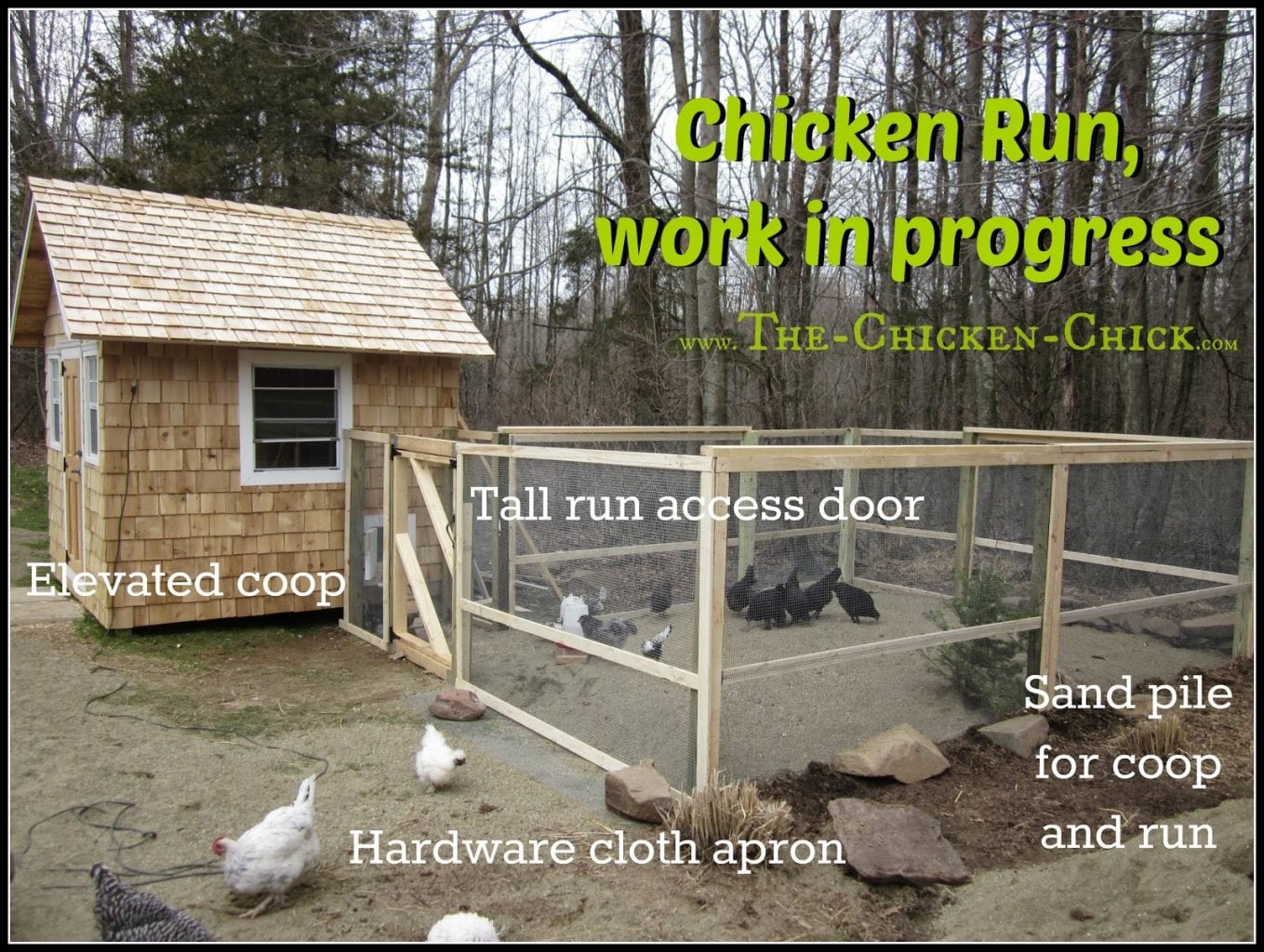
A chicken run is an enclosed, outdoor area ordinarily attached to the coop. Confined birds spend most of their days in the run. Free-range birds spend little time in the run except during inclement weather.
Run Square footage
GO BIG on the chicken run! Plan a bare minimum space allocation of ten square feet per bird in the chicken run for confined flocks. Free-range flocks will do well with less than 10 sq ft per bird, but plan for inclement weather and build it as large as possible anyway.
A spacious run gives chickens the personal space and exercise opportunities that do not exist inside the average coop. Chickens must be provided with elbow room to fend off boredom, obesity and avoid behavioral problems such as feather picking and egg-eating.
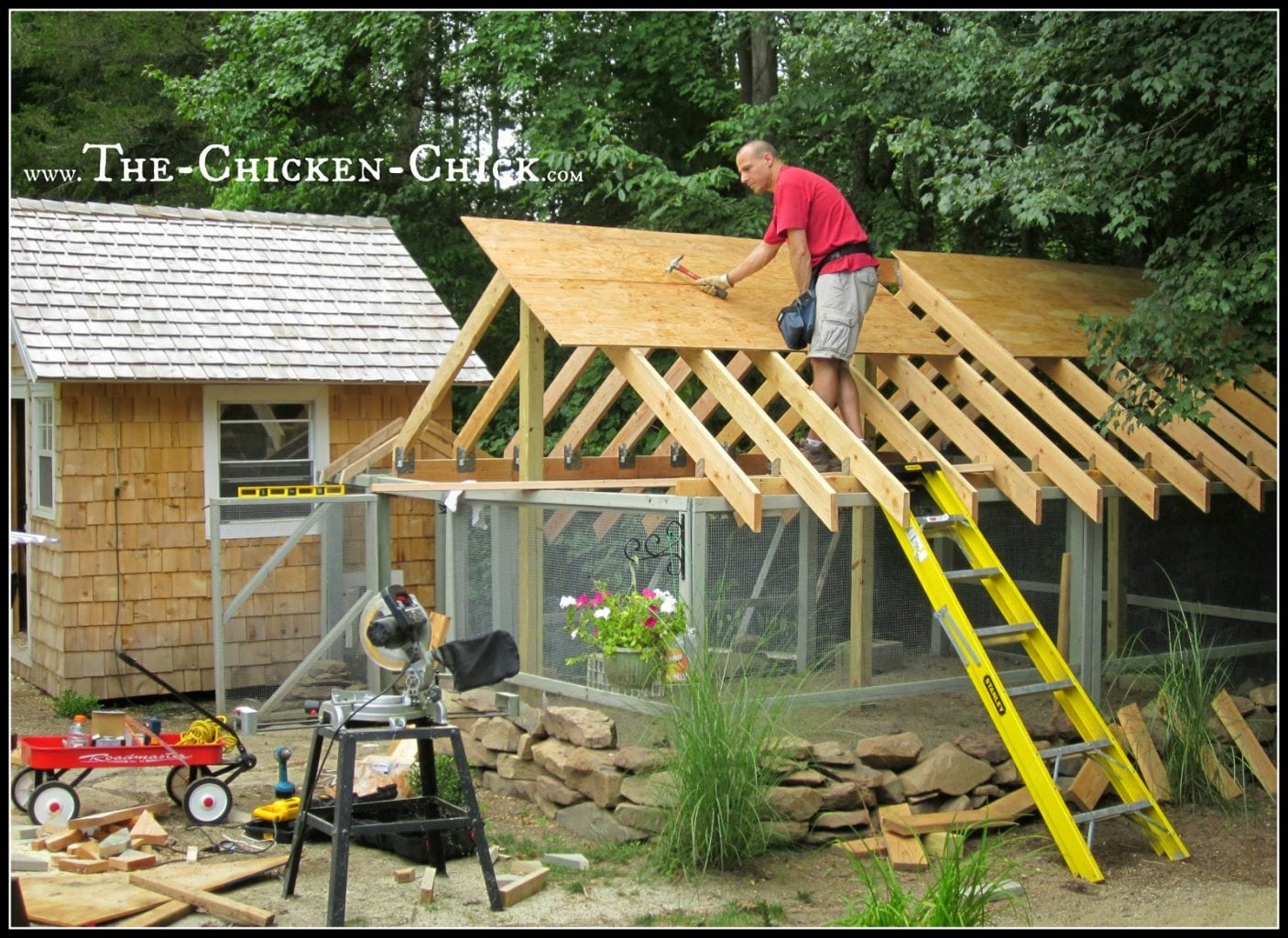
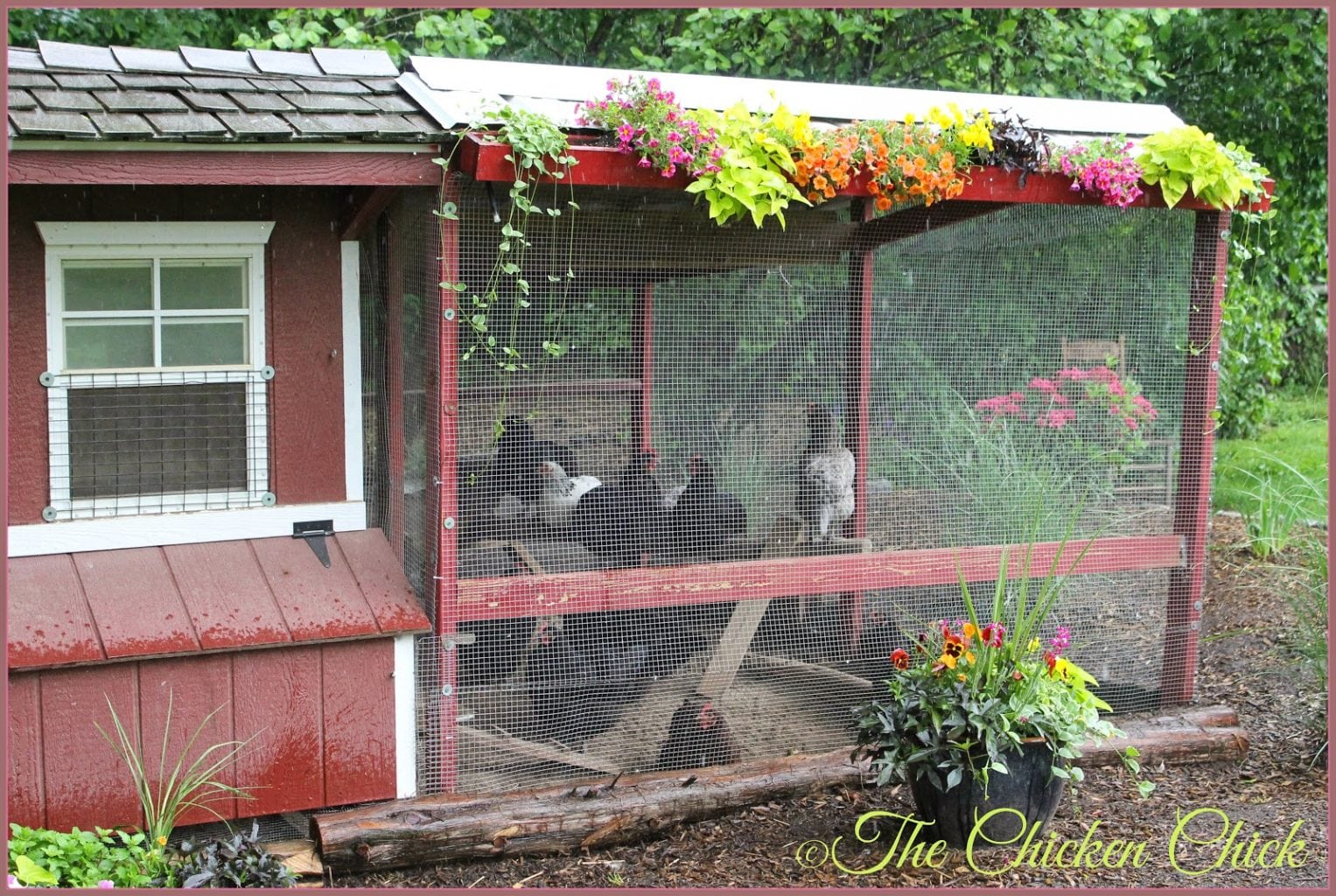
Mr. Chicken Chick went a little above and beyond the call of roof duty, but a roof doesn’t have to be elaborate to be effective.
Cover the chicken run. Seriously. Covering the chicken run allows the chickens to utilize the outdoor space in inclement weather. Roofing protects the flock from aerial predators while in the run. Netting secured to the top of the run can provide protection from raptors, but won’t help keep the flock dry and busy in the rain and snow.
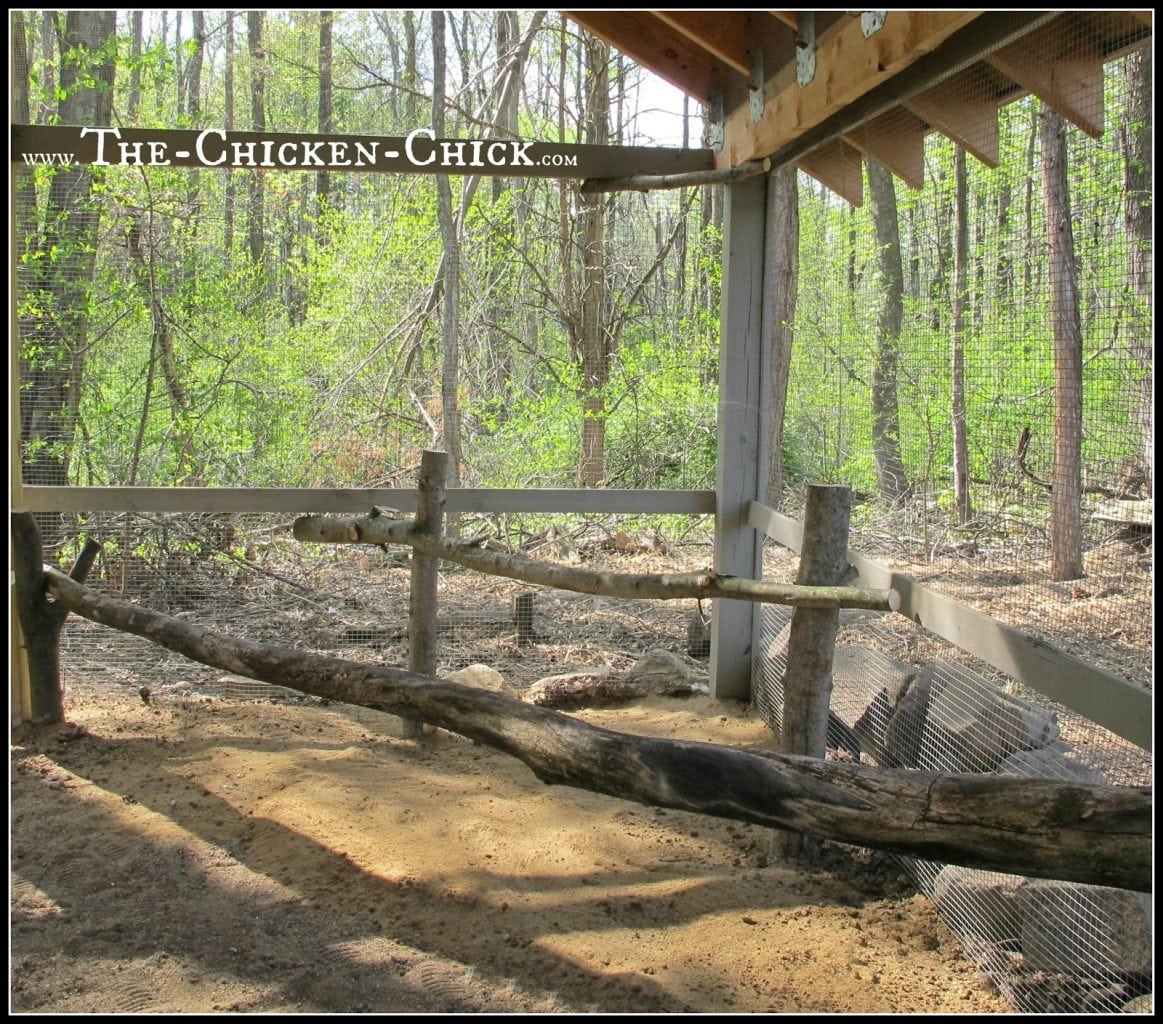
Add roosts, ladders, chairs and tree stumps in and around the chicken run. Roosting areas create additional vertical space for confined chickens.
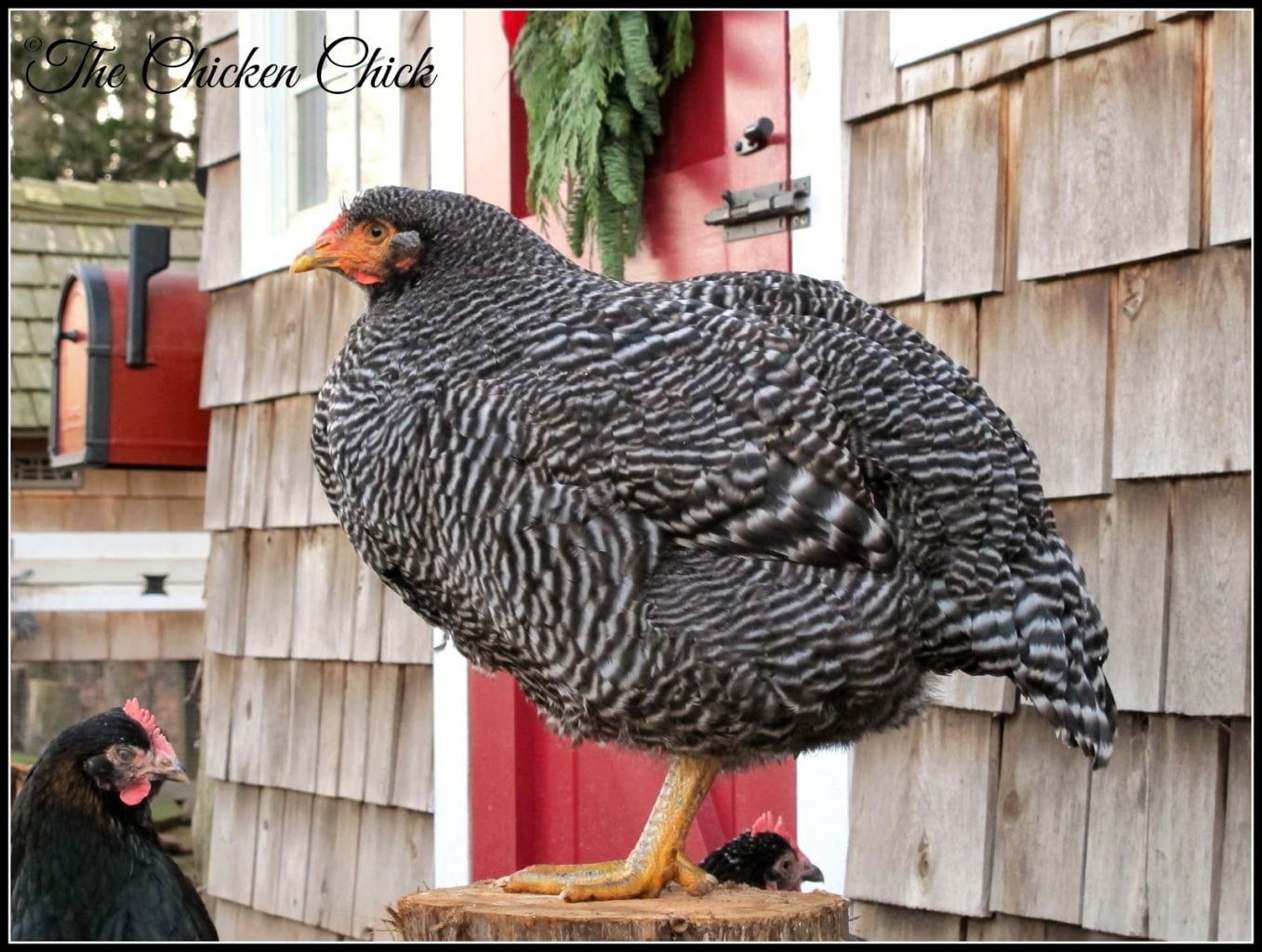
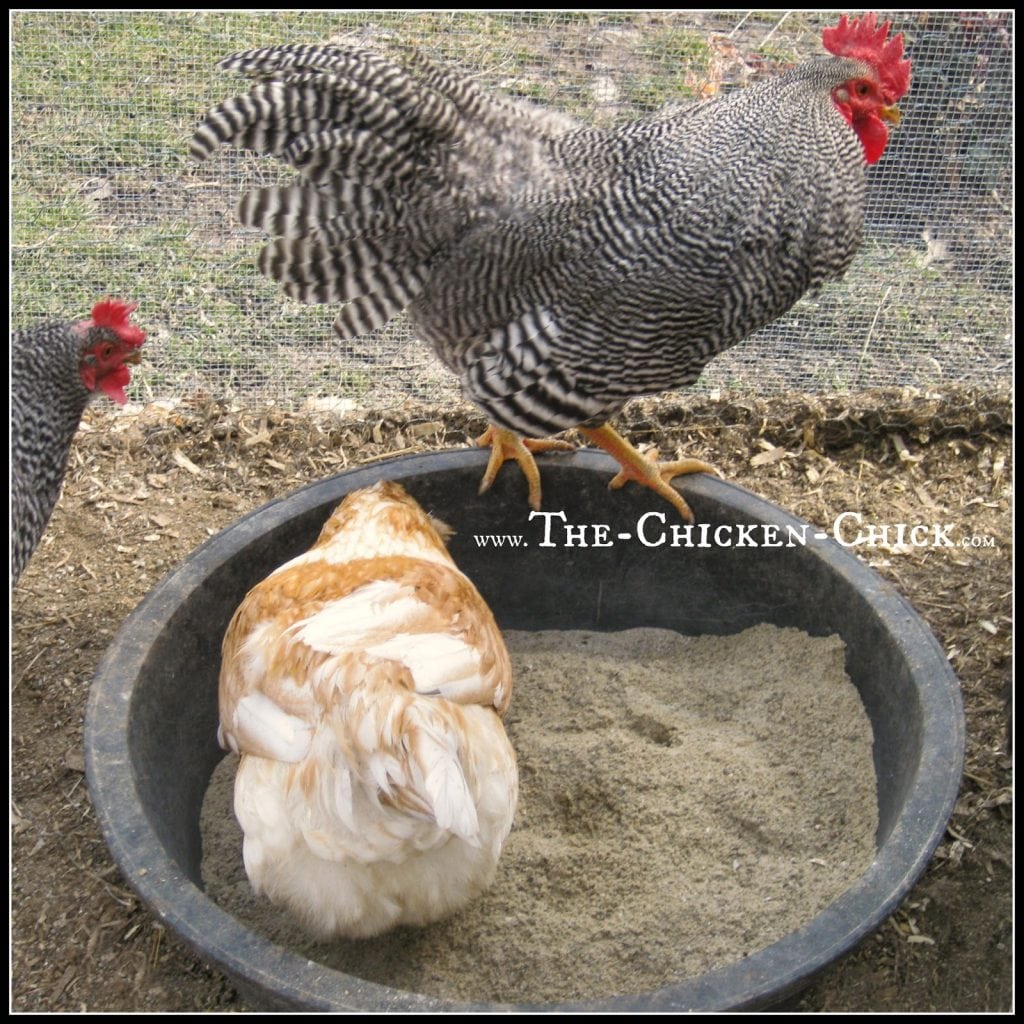
Supply dust bathing areas for chickens at all times. Sand or plain ol’ dirt are all chickens require to effectively care for their skin and feathers. Learn more about dust baths here.
SPA AMENITIES
Place a paver, large rock or cinder block in the coop for confined chickens to hone their beaks. Free-range chickens find their own emery boards in the yard.
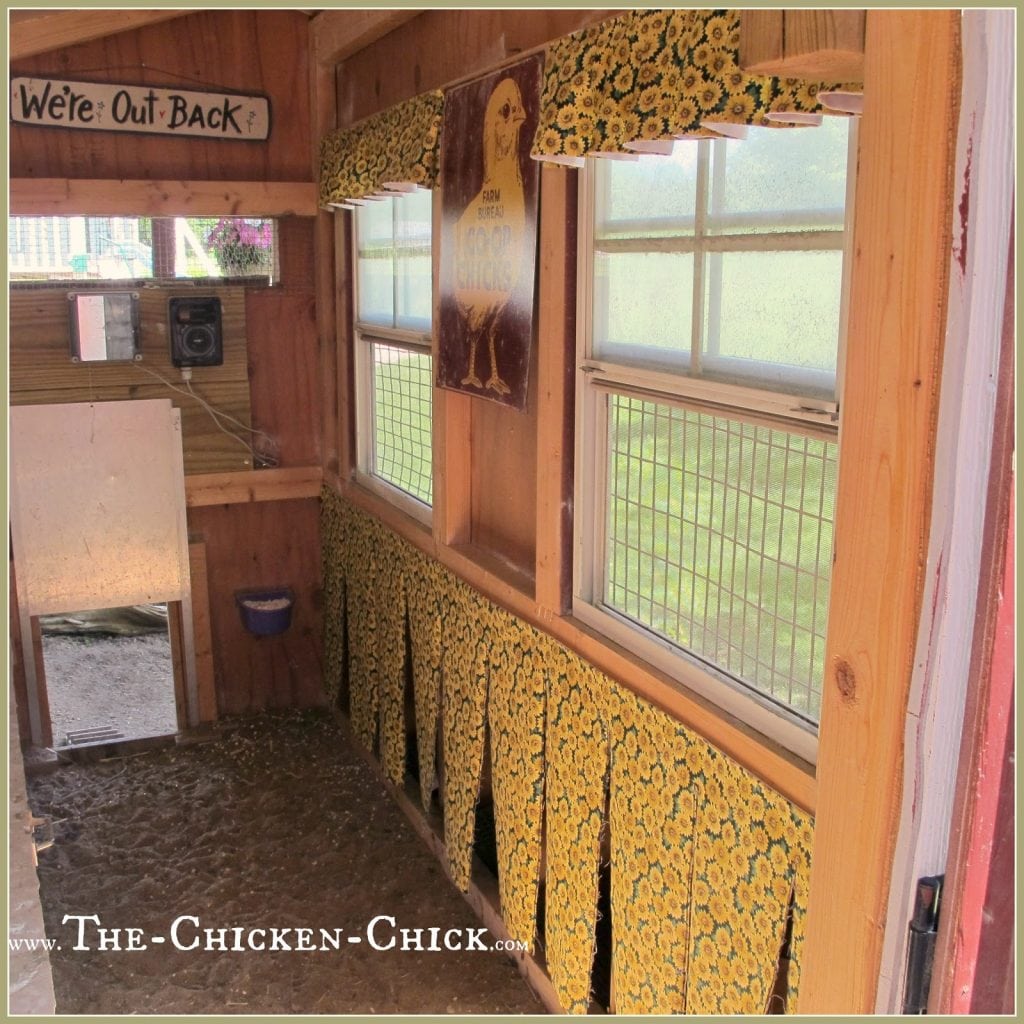
Nest box curtains
Consider nest box curtains for all the benefits they provide hens. Read all about them here!
In-law Apartment
Create a fsmall, hardware cloth enclosure inside the coop to protect a sitting hen and introduce new flock members.
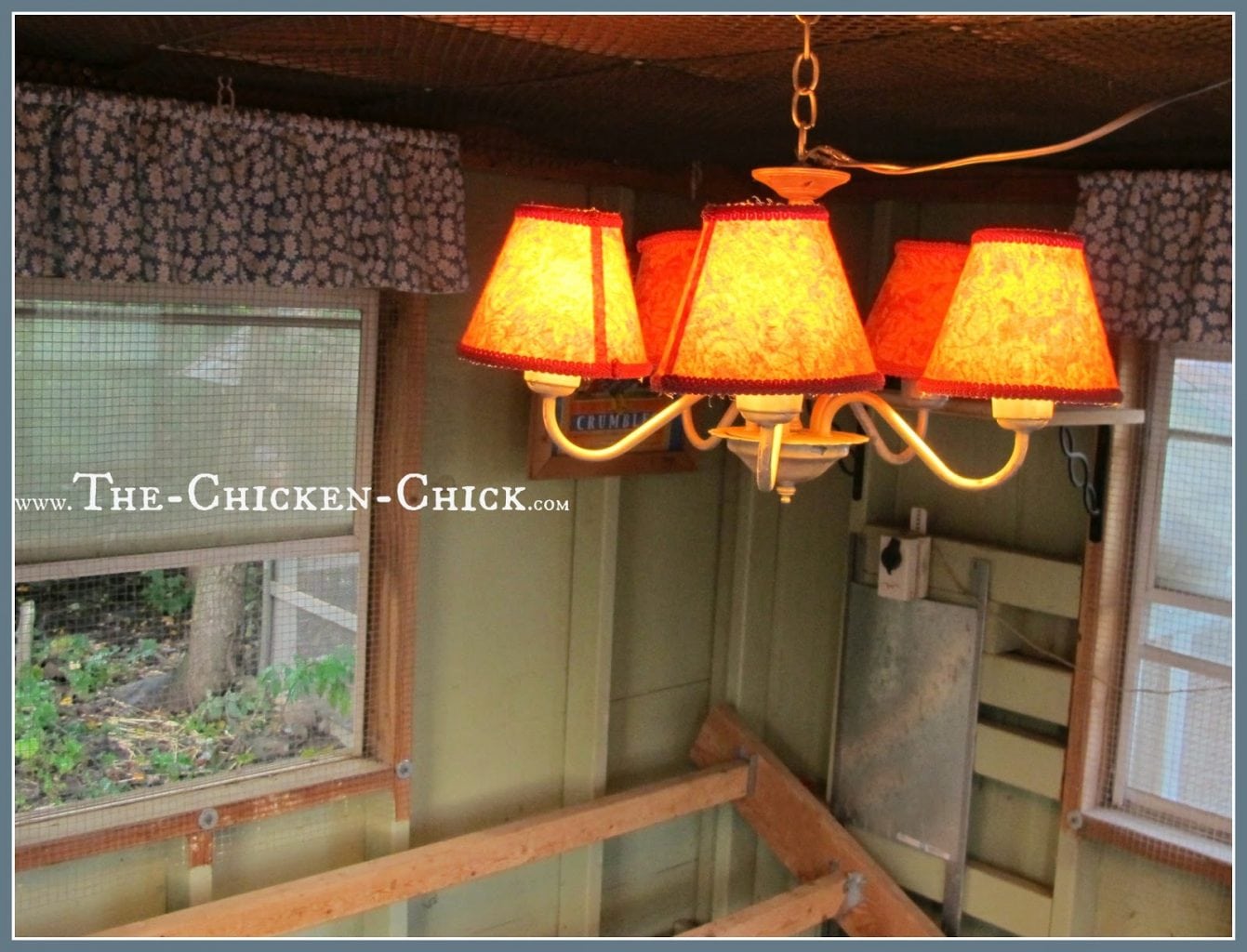
Electricity
Supply electricity to the coop to power fans in the summer, a water heater in the winter, an automatic pop door opener, supplemental lighting and a safe heat source in severe winter weather.

Running water
Ok, it’s a wish list item of mine, but it sure would be nice to have a utility sink and running water near the coop. Hey, a girl can dream, can’t she?
Kathy Shea Mormino
Affectionately known internationally as The Chicken Chick®, Kathy Shea Mormino shares a fun-loving, informative style to raising backyard chickens. …Read on


shop my SPONSORS

TIMING IS EVERYTHING
Build or buy the chicken coop before the chicks arrive! They grow at the speed of light and feather-weight baby chicks become poop and dust-generating machines in just a few weeks!

COOP LOCATION
Climate Considerations:
Anticipate weather-related challenges based on climate:
- Rainy climate? Locate chicken coop at the top of a sloped yard, not the bottom.
- Hot weather? Locate the coop in a shady spot.
- Frigid winters? Seek-out natural windbreaks.
- Super cold AND super hot seasons? Favor a shady location since it’s more difficult for chickens to keep cool in the heat than to stay warm in the cold.
- Wet climate? Avoid low-lying areas that can flood.

COOP SIZE: MINIMUM SPACE REQUIREMENTS
Allow at least 4 square feet per bird inside the coop. Plan a bigger coop than you think you need. Hear me now, believe me later: the coop should be twice the size of the anticipated need. Planning 6 chickens now? Build the coop for at least 12. There will be personnel additions to the flock!

FREE-RANGE VS. CONFINEMENT
Birds that live most of the day ranging outside the coop and run will only spend time inside the coop sleeping and egg-laying and will be fine with less than 4 square feet per bird.
Birds that are primarily confined to the coop and run should be given as much space as possible inside the coop, 4 sq feet is the bare minimum.

COOP ELEVATION
Raise the coop off the ground a foot or two- this creates additional outdoor square footage for confined chickens, a shady spot in hot weather, a dry space in the rain and a hiding spot for bullied birds. Elevating the coop also protects the bottom of the coop from wood rot. Secure the bottom of raised coops with hardware cloth, not chicken wire, to prevent predators from using the space as a hunting club or reaching a chicken inside the run.

FLOOR
Protect wood floors from moisture and wood rot with inexpensive linoleum- it makes cleaning a breeze. Secure hardware cloth to the bottom of the wood floor (facing the ground) to secure against chewing predators. Consider a lip at coop door thresholds to to prevent litter from falling out.

ACCESS
Think about how difficult it will be to get to the coop to care for the flock in the worst weather. How far is the coop from the closest water source? In hot climates, a mister may be necessary. In cold climates, shoveling, plowing, hauling water, feed and collecting eggs will be a major burden if the coop is too far from the house. Make the coop accessible. Every inch of the coop should be reachable not only for ease of cleaning, but for handling a sick or injured chicken.

People door
Provide an access door that’s large enough to accommodate human caretakers, housekeepers and wait staff.

Chicken door
Chickens use a “pop door” to enter and exit the coop. 12” x 14” is fairly standard size. A small ramp ordinarily leads out of the coop ino the run.

Access to Chicken Run
Make the door into the chicken run tall enough for people to enter without causing head injuries.



COOP SECURITY: Predator-proof the chicken coop
Install ¼ inch Hardware Cloth Liberally-Never Rely on Chicken Wire for Safety!
Secure every opening to the coop and run that is greater than ¼ inch with hardware cloth.
Deter digging predators by creating a 12″ trench around the coop perimeter and burying the hardware cloth. Alternatively, extend a hardware cloth apron 12” out from the perimeter of the run. An apron isn’t as effective as a trench, but will provide a degree of security from less ambitious digging critters. Much more about predator-proofing a chicken coop HERE.

Locks
Opt for barrel locks, padlocks, or any other lock that requires multiple steps to unlatch. Raccoons can operate simple locks and turn basic chicken coop door handles.

Plan an Escape
Formulate a human escape plan. Many chicken keepers have had the misfortune of locking themselves inside the coop or run- plan a way out.

VENTILATION/CIRCULATION
Install as much ventilation as high up on the walls as possible. Air flow is vitally important in all seasons: harmful ammonia and moisture must be eliminated and fresh air brought inside to ensure flock health.

Place windows on all four sides of the coop with open gables and/or gable vents near the top of the coop to maximize air exchange, which is important in cold weather.

LIGHT/WINDOWS
Provide functioning windows for natural light and circulation. Chickens are not built for hot weather; they have a core body temperature of ~107°F, they wear down jackets, and have no sweat glands. Temperatures over 85°F are endanger their lives. Windows are not a coop luxury, they are a survival essential. Egg production is triggered by light– let it in! Secure windows with hardware cloth attached inside the coop with screws and washers to guard against predators.

Plan for 8-12” of roost space per bird inside the chicken coop; 2x4s are commonly used as roosts, but natural tree branches accommodate the natural grip of a chicken’s foot better. Position roosts at least 12” from the nearest parallel wall, 12” from each other and no more than 2-3 feet from the floor unless a ladder is provided. I haven’t found that it matters which side of the 2×4 faces up- chickens can cover their feet to keep them warm in the winter either way.
Install roosts higher than nest boxes. Chickens instinctively prefer to roost as high off the ground as possible, if the nest boxes are higher than the roosts, chickens will sleep in the nest boxes and eggs will be laid in an unsanitary environment. Removable roosts are easily cleaned and periodically replaced.

DROPPINGS BOARDS: WASTE MANAGEMENT
Add droppings boards underneath roosts to collect chicken poop generated overnight, which removes the primary source of ammonia and moisture from the coop. Scrape boards down each morning and add them to a compost pile.

Provide one nest box for every four chickens. Nests can be at floor level or higher as long as they are lower than the roosts. Typical nest box size is 12”x12”12″. Don’t be discouraged when hens bicker over one nest box and several sit in it simultaneously- they all do it! It’s the equivalent of women going to the ladies room together. Safety in numbers, perhaps?

Be creative with nest boxes, the options are limitless: clean, empty kitty litter containers, 5 gallon buckets, baskets and upcycled televisions and computer monitors all work for laying hens!

Egg access door outside the coop frees up valuable coop floor space and allows eggs to be collected in winter without letting any heat out of the coop or tracking snow into it.

A chicken run is an enclosed, outdoor area ordinarily attached to the coop. Confined birds spend most of their days in the run. Free-range birds spend little time in the run except during inclement weather.
Run Square footage
GO BIG on the chicken run! Plan a bare minimum space allocation of ten square feet per bird in the chicken run for confined flocks. Free-range flocks will do well with less than 10 sq ft per bird, but plan for inclement weather and build it as large as possible anyway.
A spacious run gives chickens the personal space and exercise opportunities that do not exist inside the average coop. Chickens must be provided with elbow room to fend off boredom, obesity and avoid behavioral problems such as feather picking and egg-eating.


Mr. Chicken Chick went a little above and beyond the call of roof duty, but a roof doesn’t have to be elaborate to be effective.
Cover the chicken run. Seriously. Covering the chicken run allows the chickens to utilize the outdoor space in inclement weather. Roofing protects the flock from aerial predators while in the run. Netting secured to the top of the run can provide protection from raptors, but won’t help keep the flock dry and busy in the rain and snow.

Add roosts, ladders, chairs and tree stumps in and around the chicken run. Roosting areas create additional vertical space for confined chickens.


Supply dust bathing areas for chickens at all times. Sand or plain ol’ dirt are all chickens require to effectively care for their skin and feathers. Learn more about dust baths here.
SPA AMENITIES
Place a paver, large rock or cinder block in the coop for confined chickens to hone their beaks. Free-range chickens find their own emery boards in the yard.

Nest box curtains
Consider nest box curtains for all the benefits they provide hens. Read all about them here!
In-law Apartment
Create a fsmall, hardware cloth enclosure inside the coop to protect a sitting hen and introduce new flock members.

Electricity
Supply electricity to the coop to power fans in the summer, a water heater in the winter, an automatic pop door opener, supplemental lighting and a safe heat source in severe winter weather.

Running water
Ok, it’s a wish list item of mine, but it sure would be nice to have a utility sink and running water near the coop. Hey, a girl can dream, can’t she?




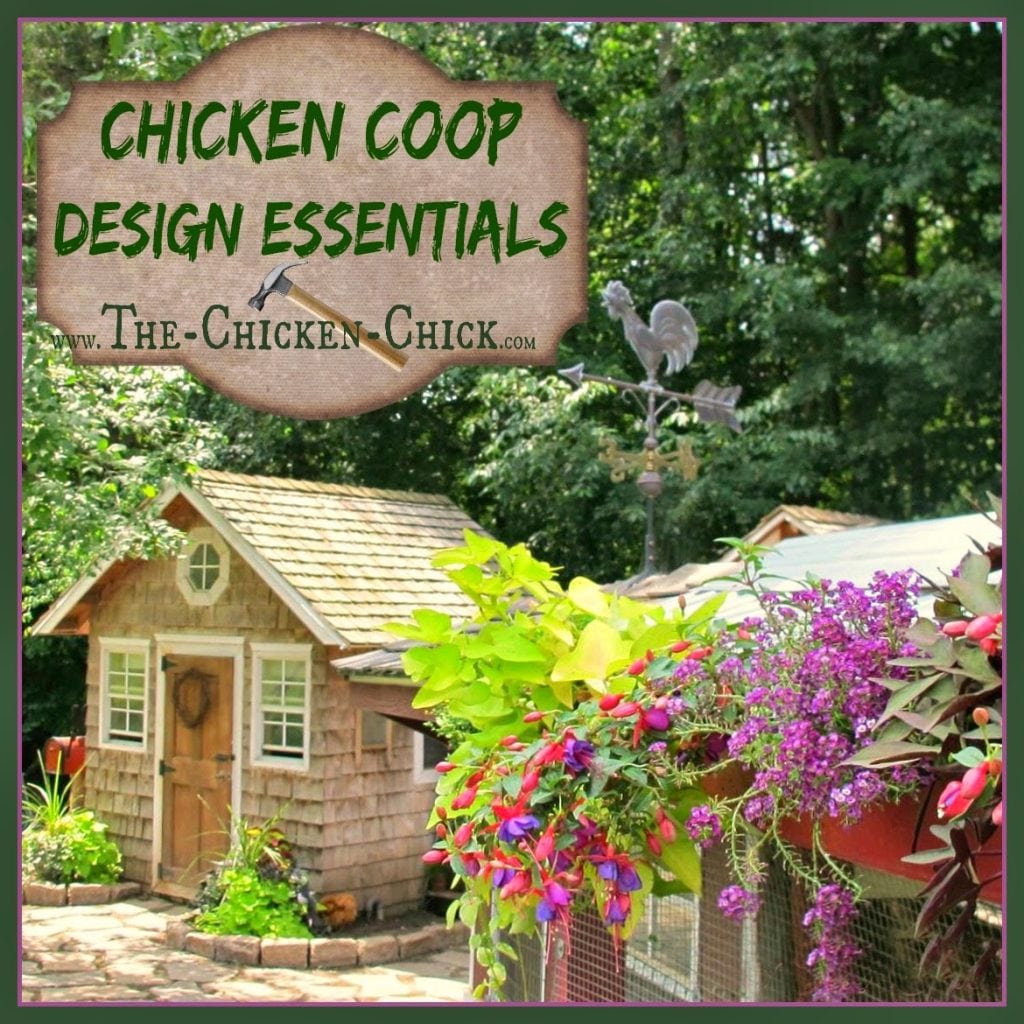



















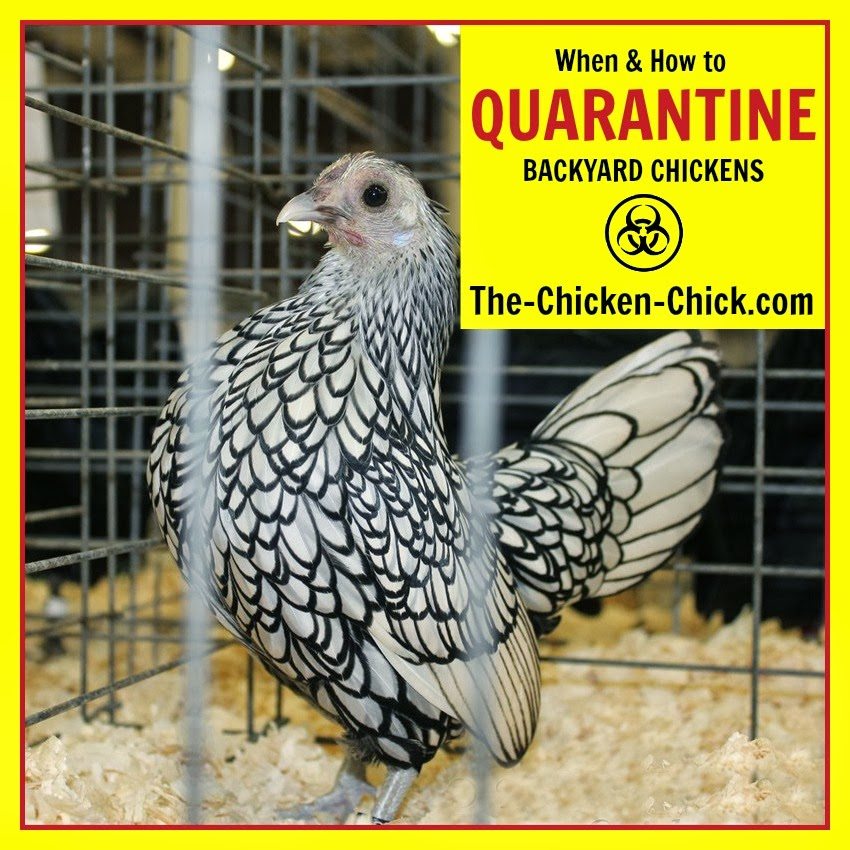















Great coop information! Do you have any insight to chickens’ sensitivity to smells? We moved into a house that has a large smokehouse firmly built with logs and concrete in the backyard. We were thinking of modifying it with ventilation, proper flooring, etc but are concerned the lingering smoke smell would be a chicken detractor? Our chickens are free range and would only be in there for egg laying and perhaps even nursery raising. They otherwise sleep high in the trees.
I wouldn’t worry about the smokehouse’s smell.
We’re hoping to get our first chicks this spring, and looking forward to it! We’ve just moved to N. Georgia and into a home that has an 8′ high (by about 15′ wide) area under an added room. We’re wondering if the coop could be in this 8′ high x 15′ wide area that faces north with its east & west sides exposed; the south side of the area is a wall of the garage. Enough VENTILATION in this “room” that has 3 open sides and one walled-off side? Also wondering if we need to think about THE SMELL that… Read more »
I don’t know if I’d want them that close. It’s difficult for me to say though because I don’t really know the layout or your flock plan.
What about the ground of the chicken run, please? Not the coop, but the run. Should I be using something special there? Thanks!
I highly recommend (and use) sand! https://the-chicken-chick.com/chicken-coop-bedding-sand-litter/
Where do you get such wide rolls of 1/4” hardware cloth? I have only found rolls 4’ wide, so would have to overlap it on the run with fasteners. It looks like you have a single sheet on each side of your run.
4′ is the largest they make.
I would love if you talked about or blogged about the fans you use in your coops.